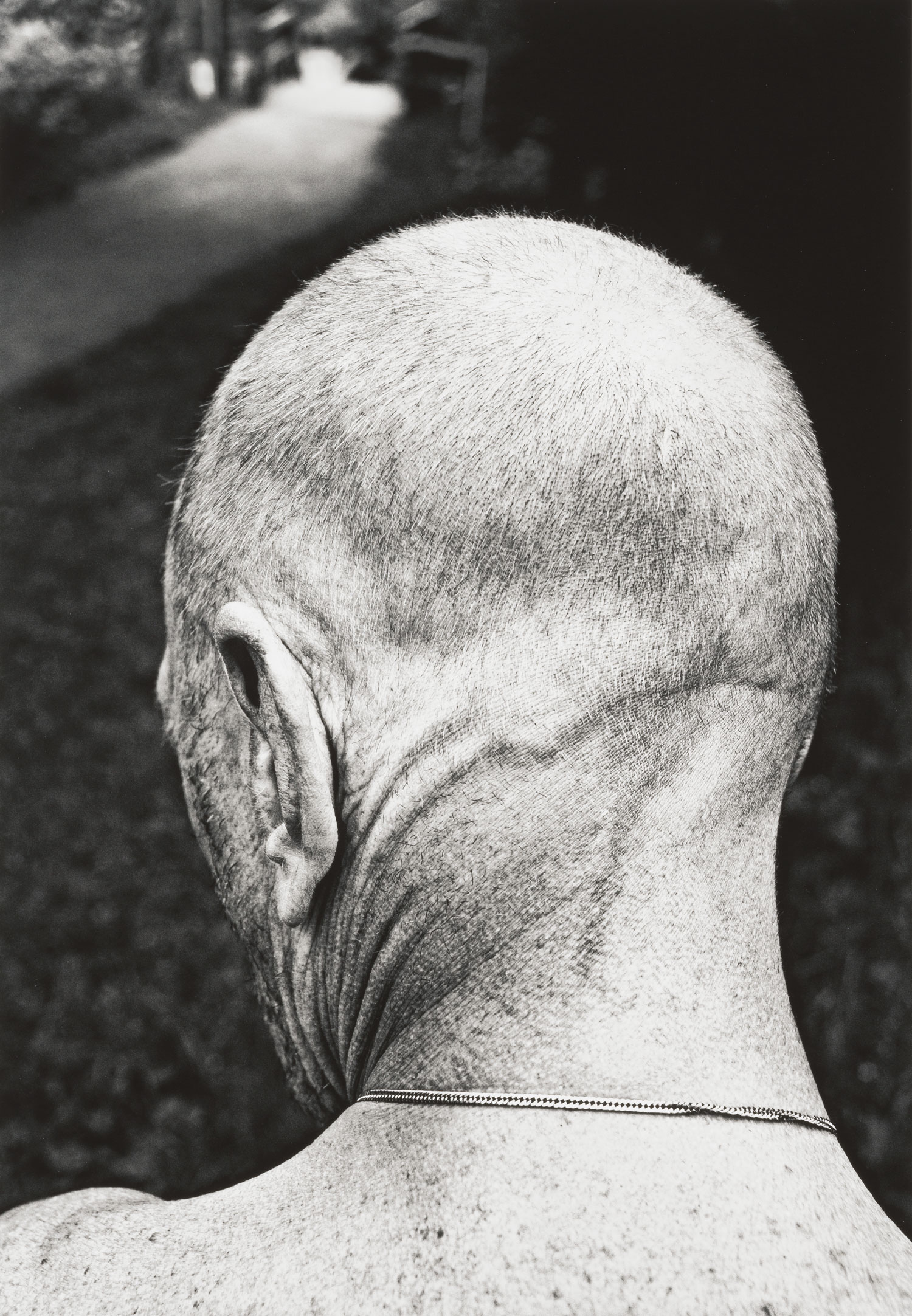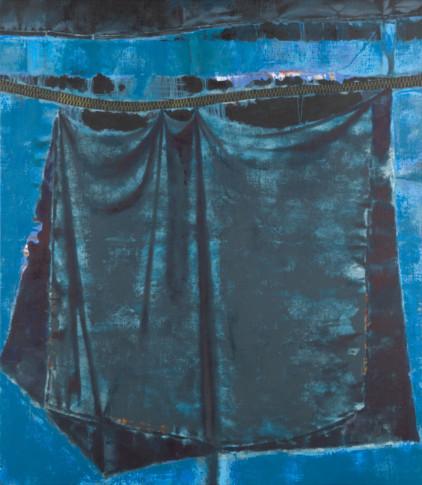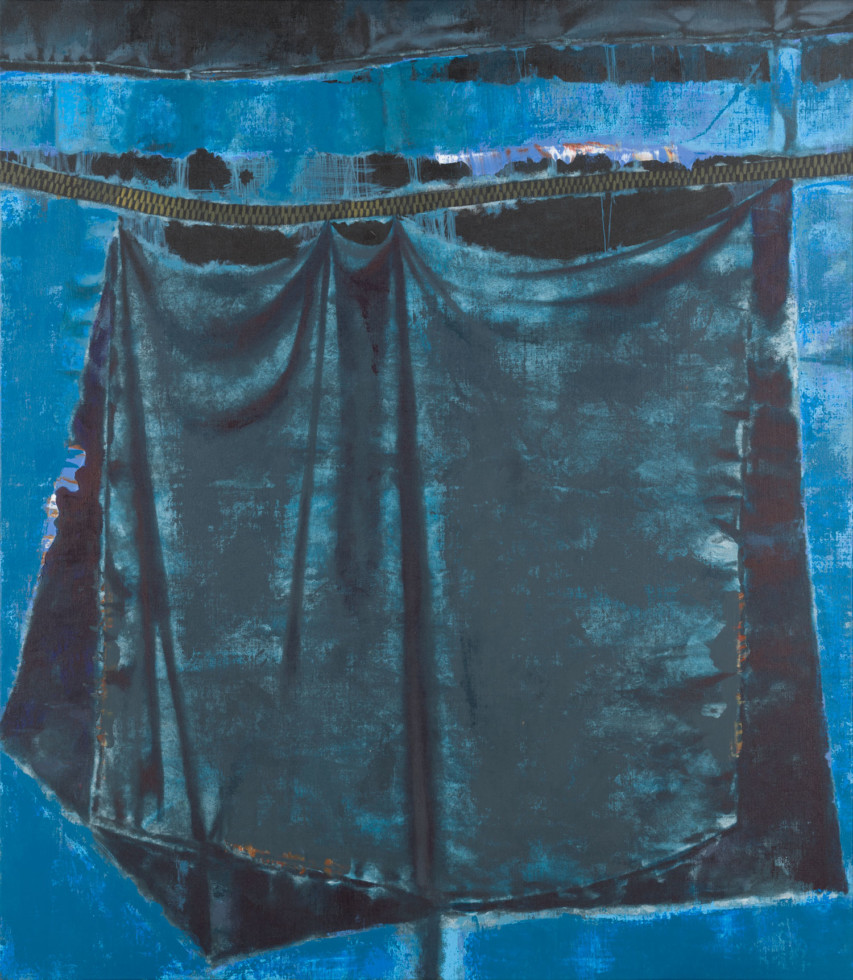
Mohammed Sami, Joseph's Coat, 2020 Photo: Tobias Fischer/Moderna Museet © Mohammed Sami
Participating artists
Afrang Nordlöf Malekian
Born 1995
“My Dear Dad Said”, 2016 and “The Art of Cooking With Communist Dreams – From Garlic to Onion”, 2021
The video work “My Dear Dad Said” shows the artist drawing the contours of his own arms placed on his naked torso with a brush dipped in black ink. The words “My Dear Dad Said” are repeated in a neutral voice, followed by violent threats but also by exposed vulnerable pleas for help. Every word leaves traces on the body, which eventually turns almost totally black. In “The Art of Cooking with Communist Dreams – From Garlic to Onion”, three Persian recipes reveal how grand political visions impact on the individual family, on the home and its women and children. The visions and recipes live on outside the borders of Iran, in those who dared to dream of another future, and who were forced into exile with their ideals and their food in the same bag.
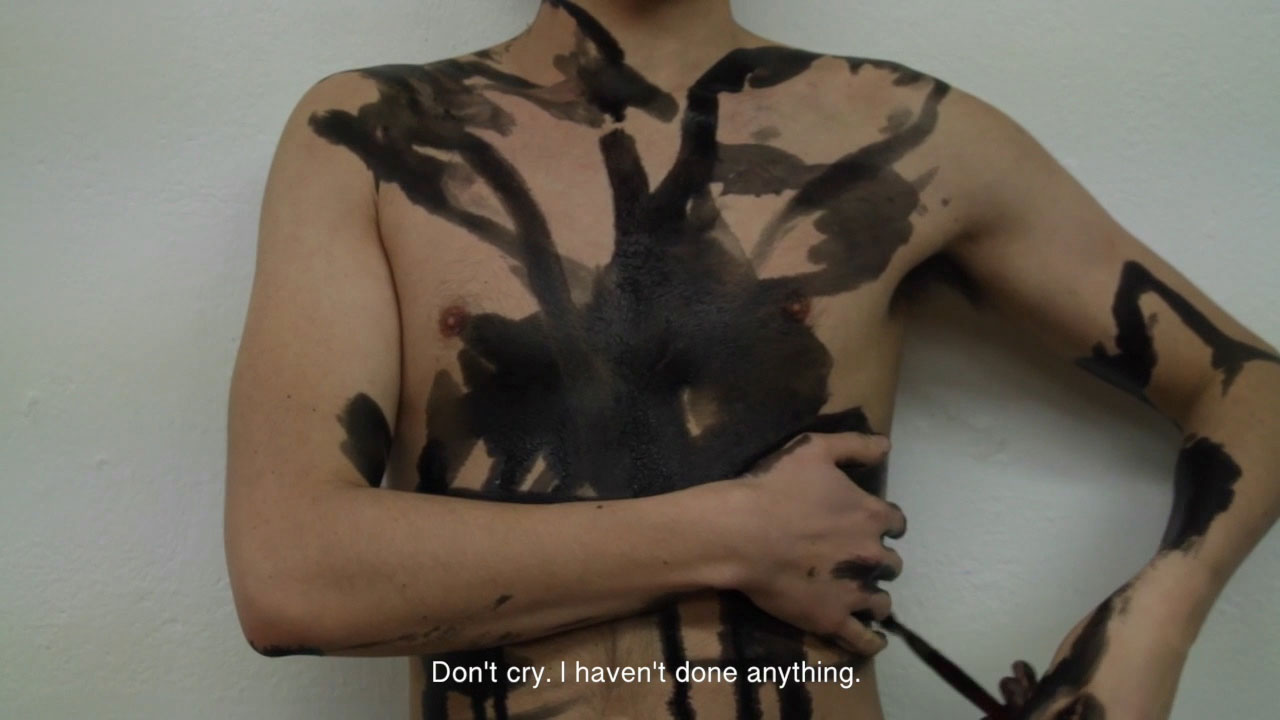
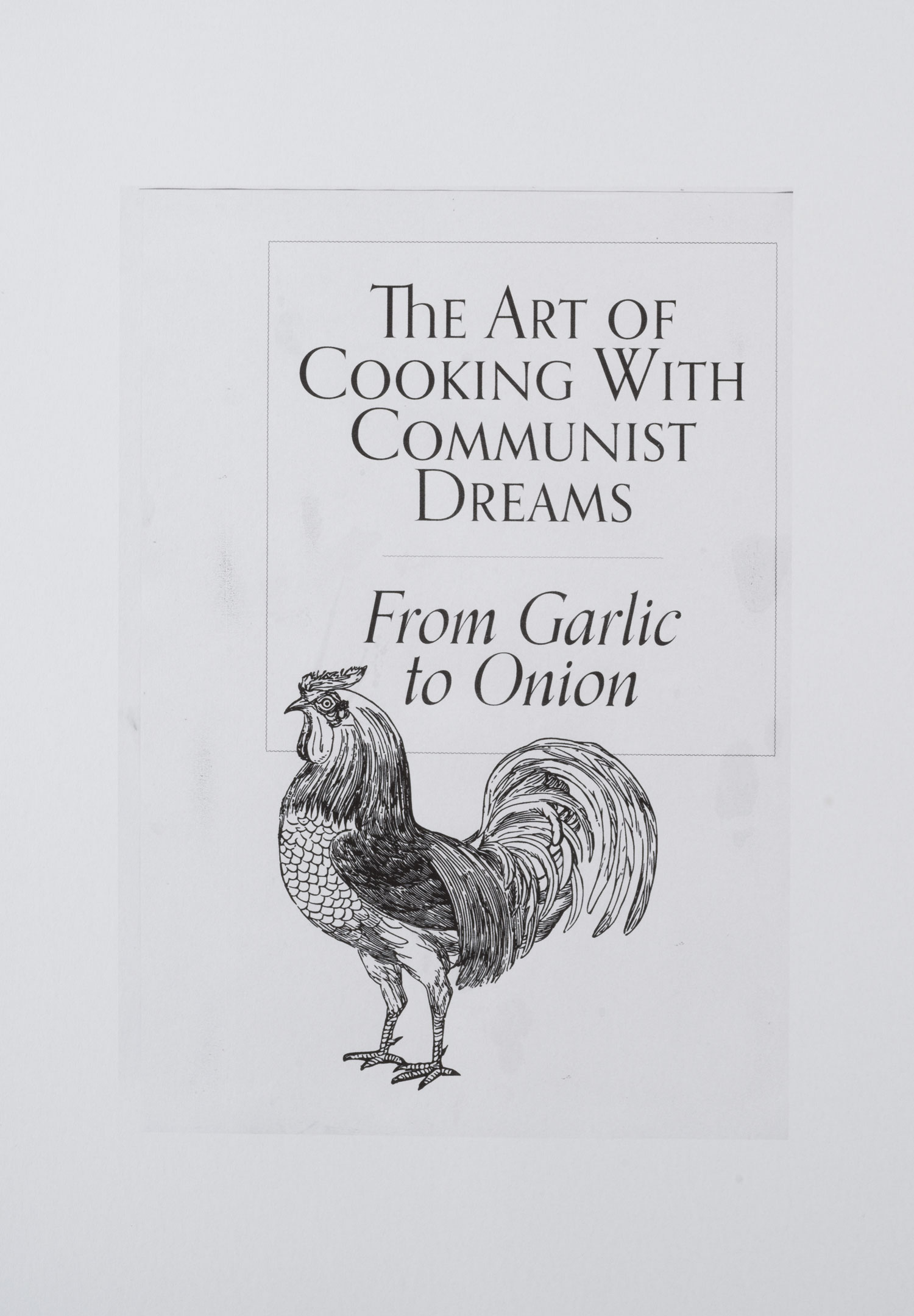
Astrid Svangren
Born 1972
“Hair and clothes are pinned up for observation volatile odours they expose themselves to scented fumes and after that adorn themselves in an animal’s fear and finally, turn away from the centre”, 2021
In her works, Astrid Svangren seeks to capture fleeting memories, sensations or moods. The spatially extended paintings are created in long processes, where Svangren strives for a kind of precision. Many of her works are held together by a structure; here, pieces such as fabric strips or crumpled aluminium have been woven into chicken wire. Familiar materials, which spark associations. The long title gives us a direction, a visual possibility. We can discern the various fragments as pure abstraction. The frosty tones, glimmers of gold, like sunshine on snow, can also awaken memories of a crisp winter’s day.
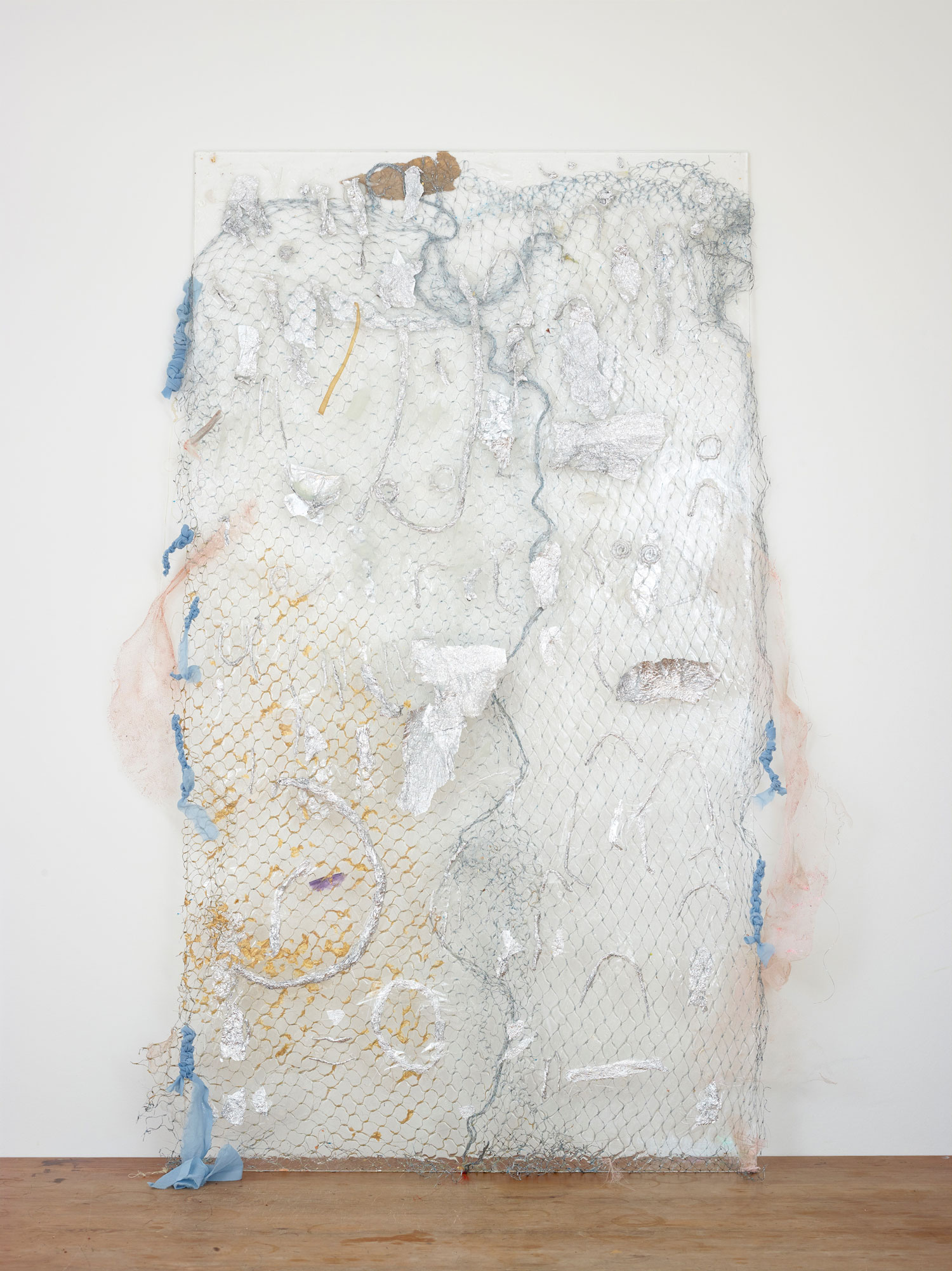
Carola Grahn
Born 1982
“Horizon of Me(aning)”, 2021
The sculpture is a horizon of birchwood stacked according to the artist’s detailed instructions. This monotonous task should be performed in seclusion while discussing mental health. The work was first performed in 2015, following several suicides in Sápmi, and in the version acquired by Moderna Museet, Carola Grahn has built the sculpture together with the poet and yoik singer Simon Issát Marainen who lost two brothers. In harmony with a life philosophy where nature is animate, the firewood can be imagined as harbouring these stories, like the forest seems to hear our confessions. The long, wood-smelling pile is also a silent testimony of physical labour and a promise of future fire.
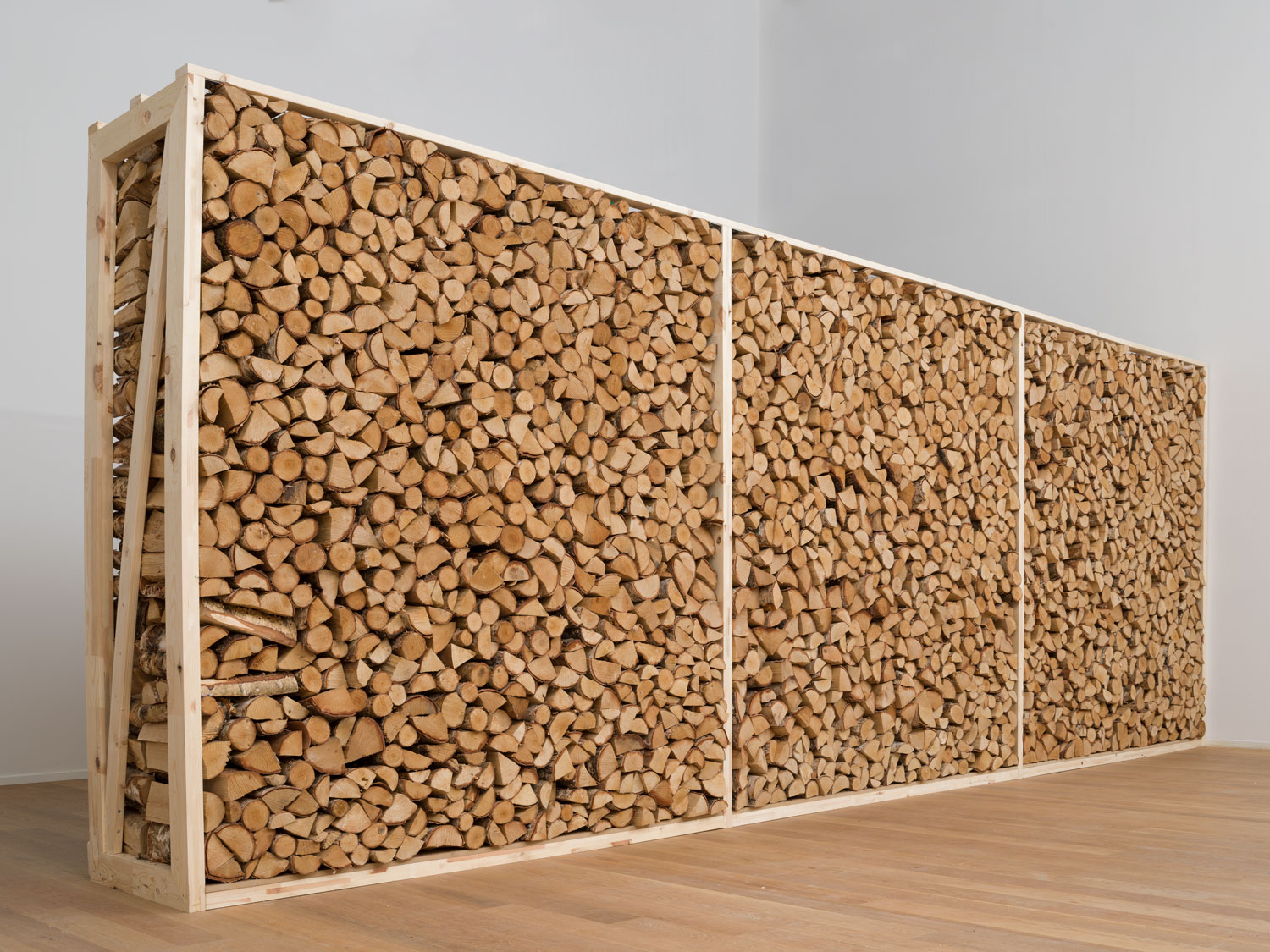
Esse-Li Esselius
Born 1948
“SX-70 Portrait of the Artist in Transsexual Transformation #1, #2, #3”, 1979/2021
When Esse-Li Esselius began experimenting with a Polaroid SX-70 camera in the late 1970s, two transformation processes were combined. After exploring gender and cross-dressing for several years, Esselius also started documenting her transformation in a series of self-portraits, manipulating the chemical development phase. In the photos, we meet a gaze with heavy makeup and a young body emerging from the dark. Organic patterns and crackles spread across the pictorial surface like organisms with a life of their own. The Polaroids have been enlarged and printed with modern technology on the reverse side of acrylic glass sheets. Esselius is previously represented in the Moderna Museet collection, but these are the first of her works acquired under the name Esse-Li. Esse means “to be” in Latin.
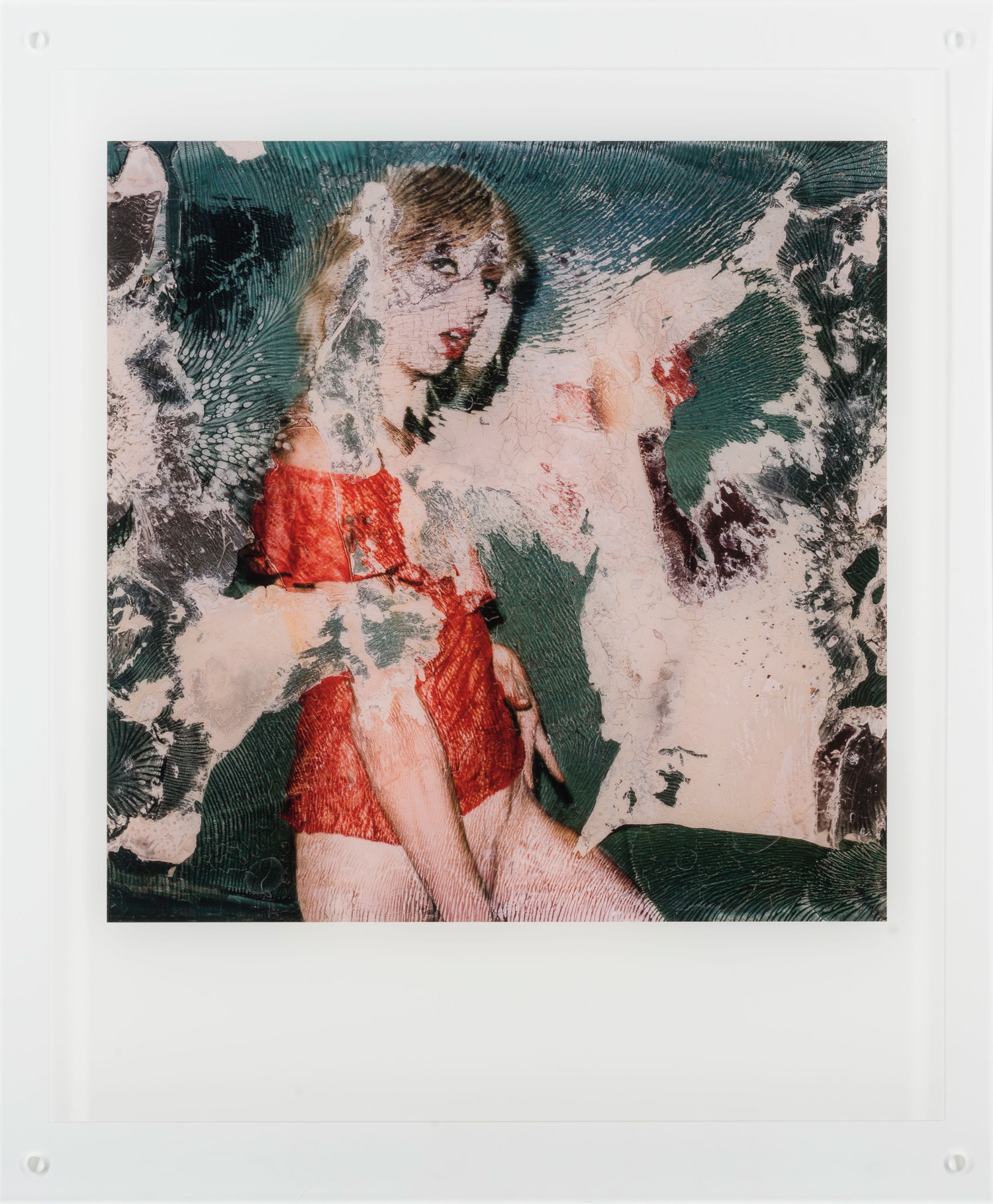
Fatima Moallim
Born 1992
“Family Album”, 2021
“An abstraction of my family situation.” This is how Fatima Moallim describes the sensitive drawing that unfolds its links and nerve threads across a mottled-grey linoleum carpet. It could also represent a substitute for the family album that never was. The black figure in the middle is the artist herself as a child, but could just as well be someone else. The child is ensnared in lines and bodies that tug in different directions – a web of relationships, feelings and tangles. For Moallim, drawing became a way of processing a childhood with no natural sense of context. The lino refers to public housing. This hard-wearing imitation of stone forms the background for Moallim’s fragile lines, which resemble rock carvings or hieroglyphs.
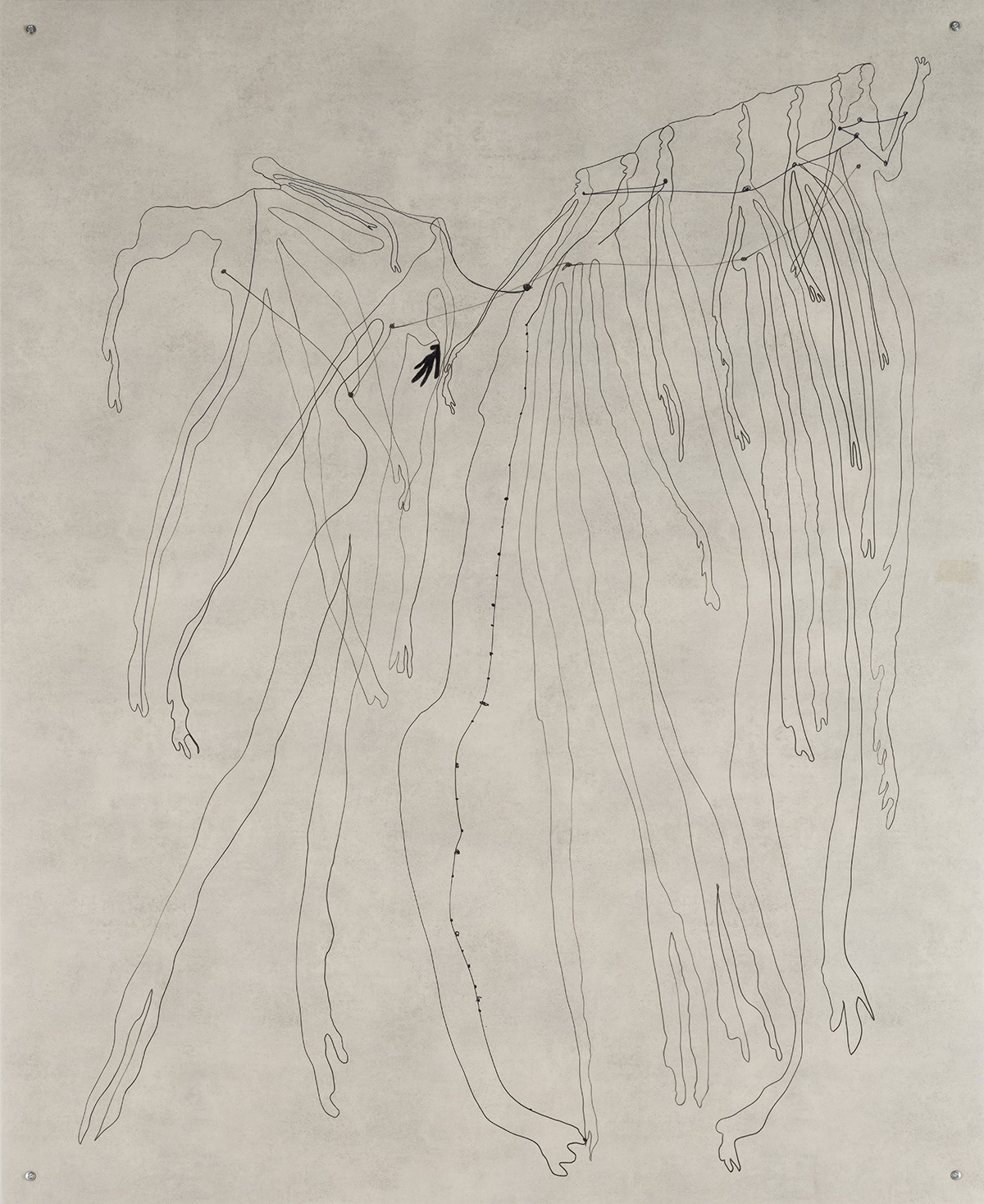
Gabriella Ioannides
Born 1964
“Seated figure”, 2018–2021
With subtle means, Gabriella Ioannides conjures up illusory and evocative pictorial spaces, like quiet stages for mysterious dramas. Here, body parts share the room with abstract forms. Contrasting colour fields and shadows suggest depth and hollows. Sometimes, a table or bed appears in Ioannides’ images, but these particular paintings are free from any allusions to the rooms we normally inhabit; all that exists is the pictorial space. The body is fragmented but not dismembered, as if every limb has its own life, its own autonomous existence, its own life experience. The painting “Seated Figure” opens up an illusory opening to the white wall behind it
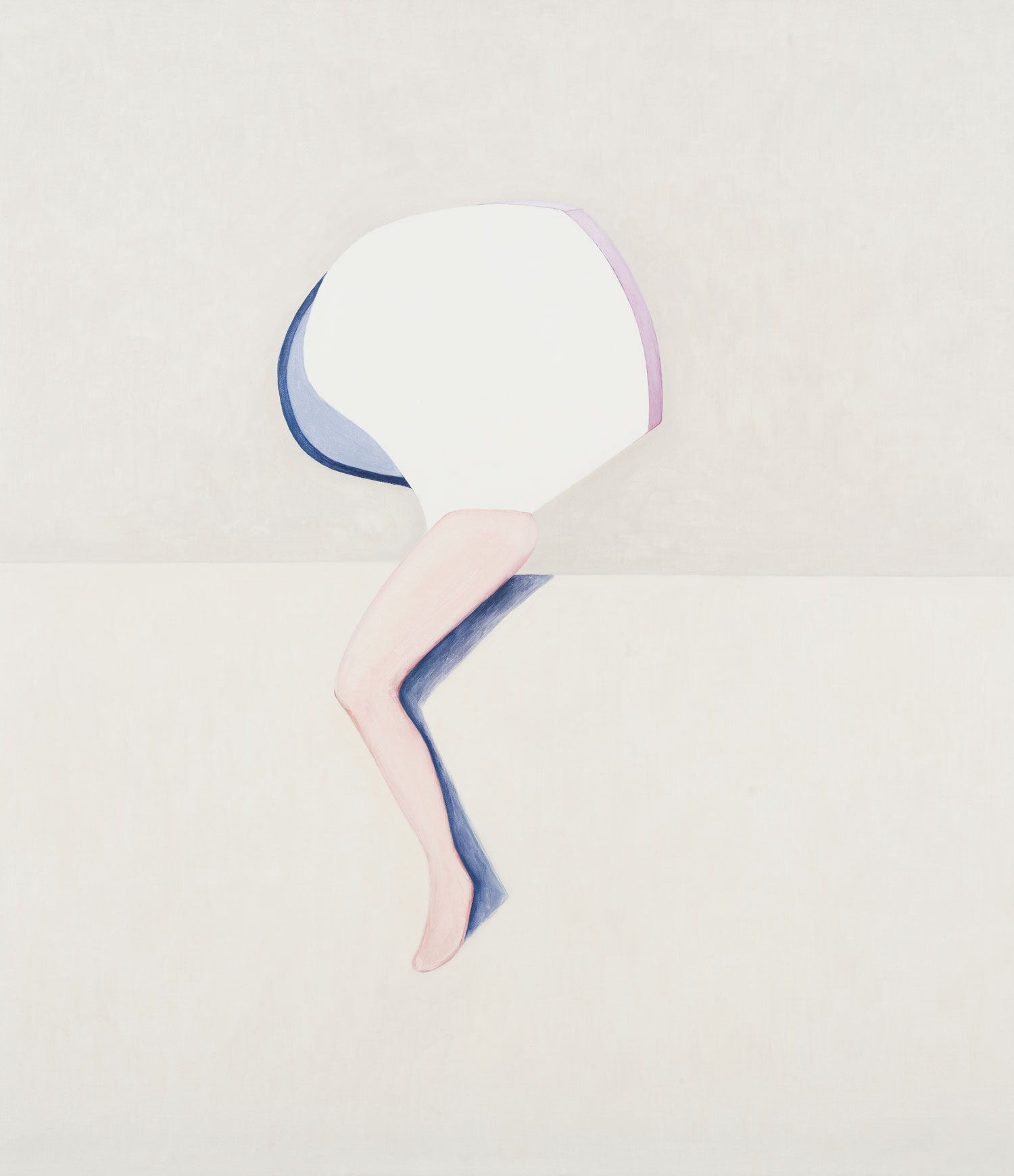
Gideonsson/Londré
Founded 2009
“The Hour of the Wolf”, 2017
The wolf hour is the time between 3 am and 5 am when many body processes take place, often while we are asleep and don’t notice it. Biorhythms are linked to earlier evolutionary stages, when we existed under different conditions. The artist duo Gideonsson/Londré often use regulated activities pertaining to perceptions of time, to channel an inner body clock and surrender to its biological rhythms. These rhythms oscillate and sometimes surreptitiously take over. The purpose of the exercises is to let go of the self and achieve a more dissolved being. The drawings were made as part of the artist duo’s explorations of various states and experiences of bodily changes in the early morning hours.
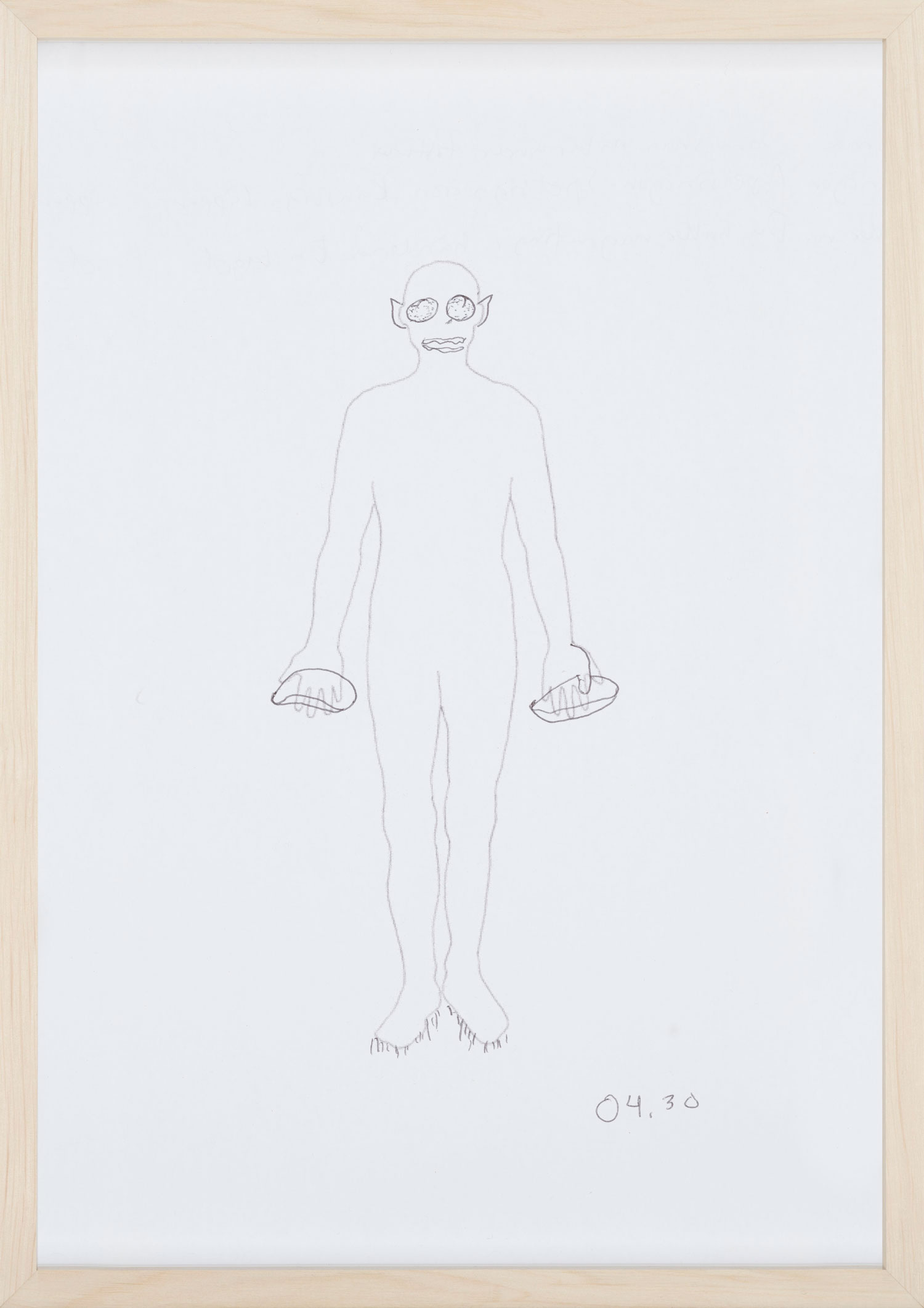
Hans Lannér
Born 1947
“My beloved”, 2020 och “A Speck of Blue”, 2020
You have to start somewhere, and Hans Lannér often starts with a house. The subject matter is important, but only as a warmup for the real thing: Painting itself. Every seemingly random line and speck of colour maintains the precise balance of the composition. Colours are applied in thin layers. In “A Speck of Blue”, clothes are hanging to dry outside a whitewashed building.
“My Beloved”, where the shutters are wide open, is from roughly the same place, the countryside in Tanzania, where the artist likes to go. The houses may look familiar, even to those who have never been there. This is also characteristic of Lannér’s imagery. The places are recognisable to us, yet unknown.
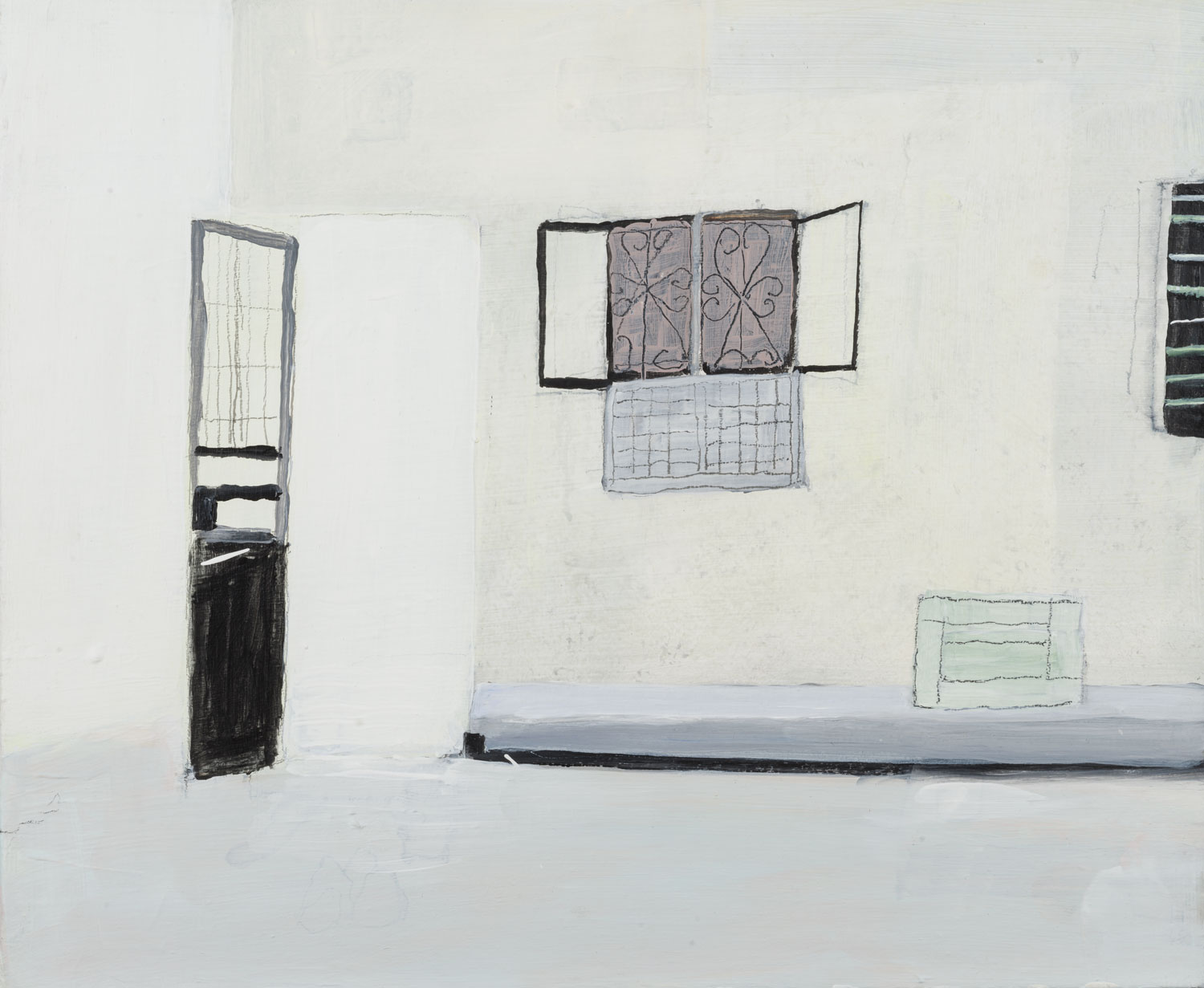
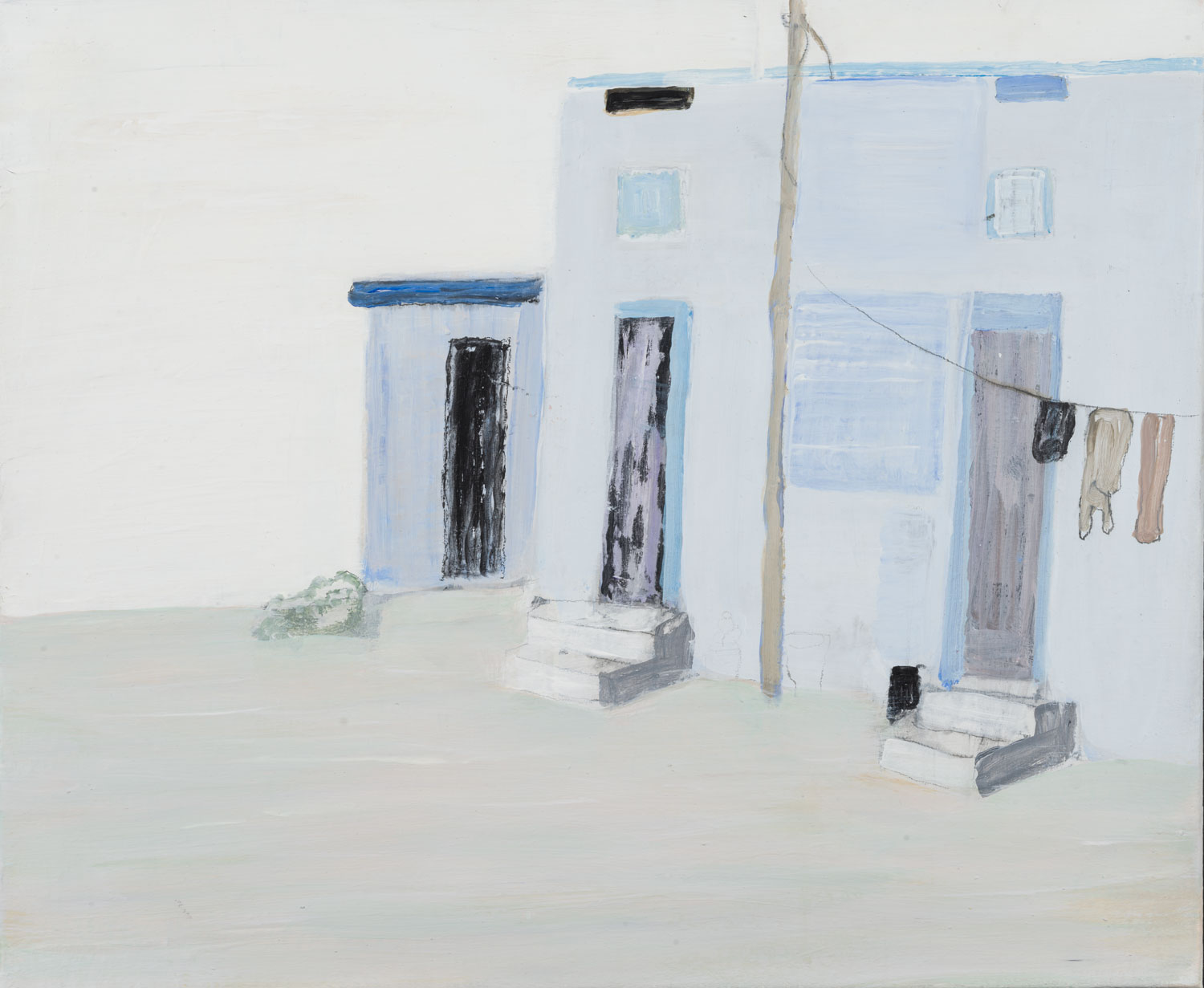
Helena Lund Ek
Born 1988
“Alice & Paula”, 2018
The double self-portrait “Alice & Paula” is from the series Crack an Egg, painted in egg tempera on gesso mixed with sand. By using this medium, which also alludes to the abortion theme, Helena Lund Ek seeks to emphasise physicality. The work conveys both gratitude and involuntary guilt, a painful ambivalence that is rarely portrayed outside the female domain. It concerns controlling and being controlled by the body. As so often in Lund Ek’s practice, motif, material, body and spiritual development interact. Her lively dialogue with previous generations is present in the title, a reference to the portrait painter Alice Neel (USA) and the magical realist Paula Rego (Portugal), whose works were mentioned in the debate on legalising abortions in her country.
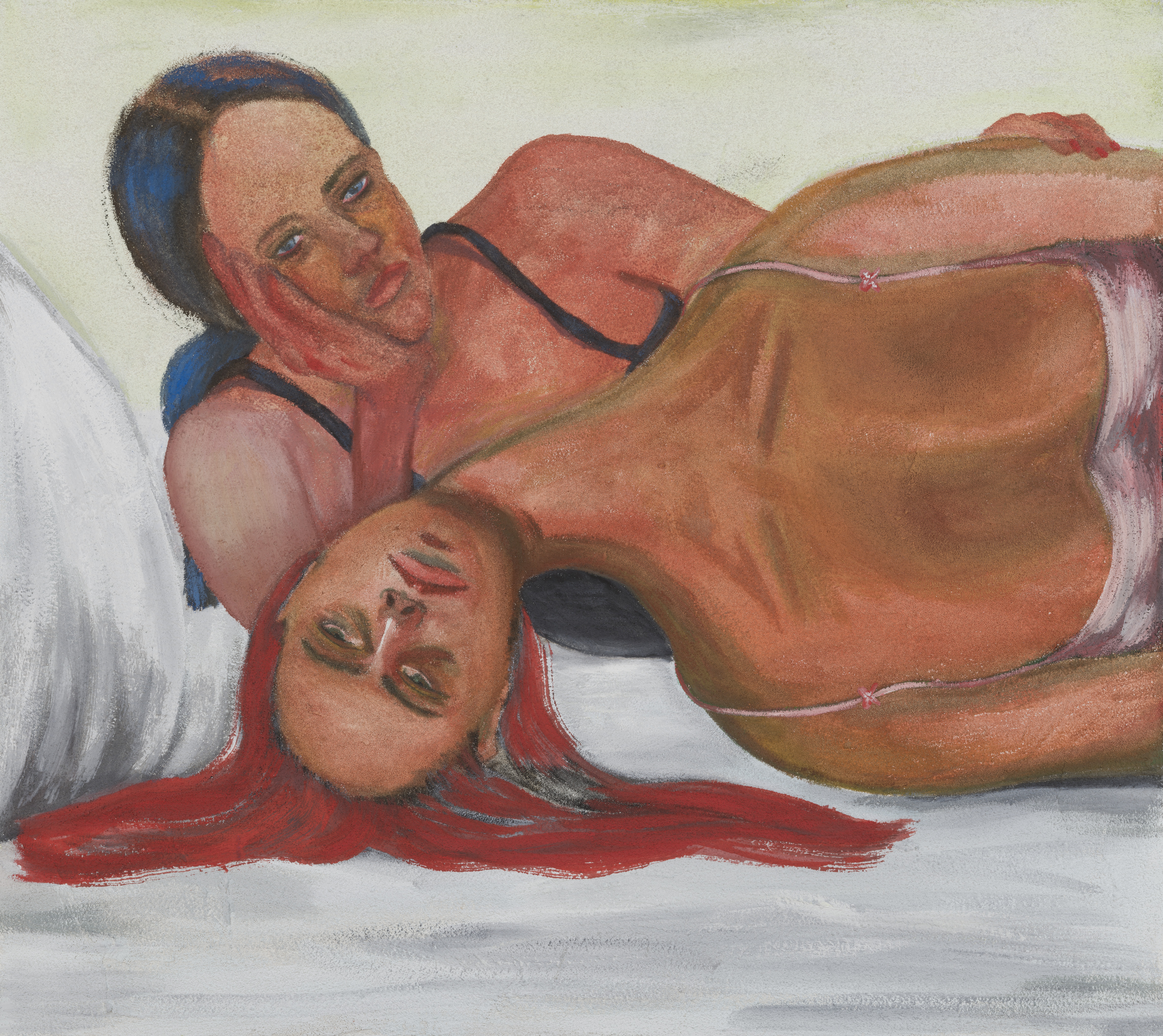
Idun Baltzersen
Born 1987
“Studies of People and Myself Exercising”, 2021
“Studies of People and Myself Exercising” is a sketch book, in which Idun Baltzersen shows people’s unvarnished everyday life. Behind the images lie hours of experience of bodies exercising and studying themselves. With bold ink lines, she draws them almost as if they were sculpture studies. One of her inspirations is the renaissance artist Piero della Francesca’s (1415–1492) paintings of people posing. Idun Baltzersen often uses her own body and face as a reference point when highlighting how social media affect how we present ourselves to the gaze of others.
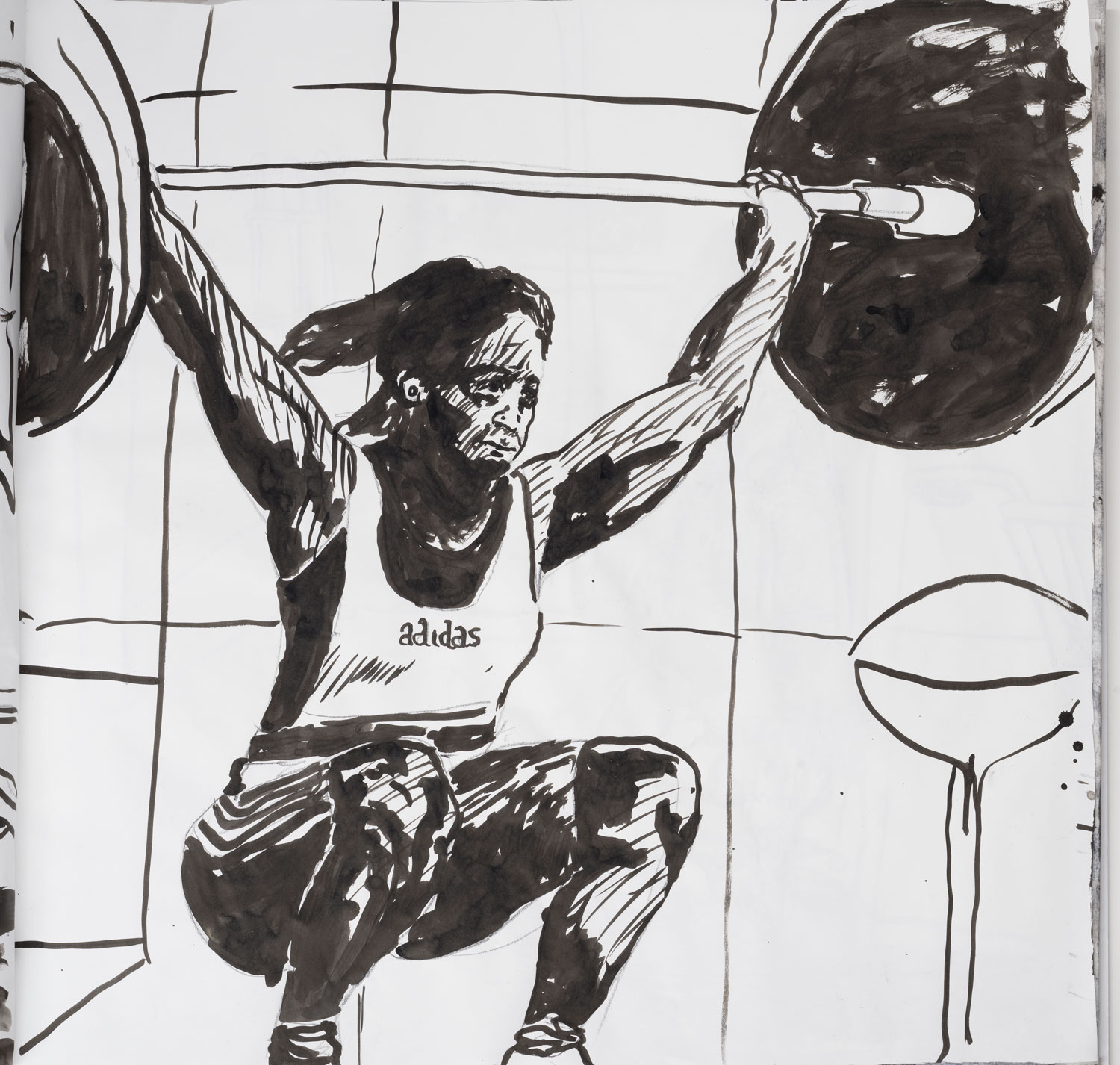
Ikram Abdulkadir
Born 1995
“Dabeesha”, 2021
Friendship and sisterhood are key themes in the images by the poet and photographer Ikram Abdulkadir. The portrait of her little sister Salma, with her veil billowing in the wind and hiding her face, is one of many where Abdulkadir has followed and documented young women in Rosengård in Malmö. The camera focuses on the building facade behind her sister, who seems to merge with it. The lighting is natural, the colours warm, the composition straight-forward. Abdulkadir works in a photographic tradition that portrays life in urban settings. She often uses familiar places and people who are close to her. The result gives us glimpses of intimate, relaxed moments, images where the domestic sphere extends into the city. “Dabeesha” means “the wind” in Somali.
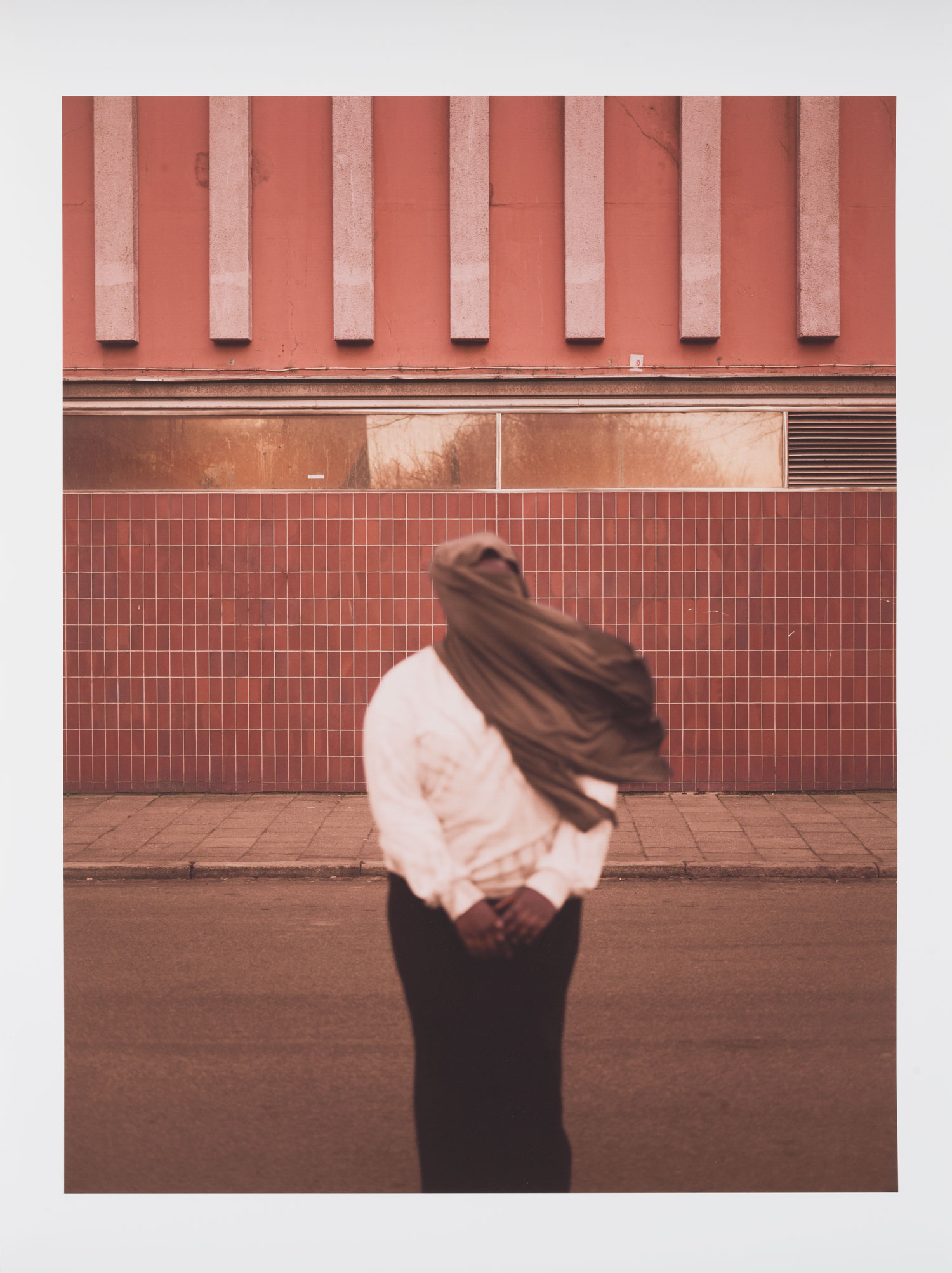
Juan-Pedro Fabra Guemberena
Born 1971
“Gladys”, 2014
This work is named after the artist’s aunt in Montevideo, the oldest in a family where singing has long been a way of creating a community spirit. Gladys sings a melancholy song that causes her emotions to erupt. Compassion and feelings of loss rise to the surface when she breaks off to talk about what grief does to the survivors when someone close dies. With its Spanish origin, this song belongs to a tradition in Uruguay that, like tango, embraces feelings of longing and lament. Gladys’s generation is the last who can recall a country that many came to from across the Atlantic to start a new life. She also belongs to a generation of women who lived during the military dictatorship while providing a strong foundation for their family.
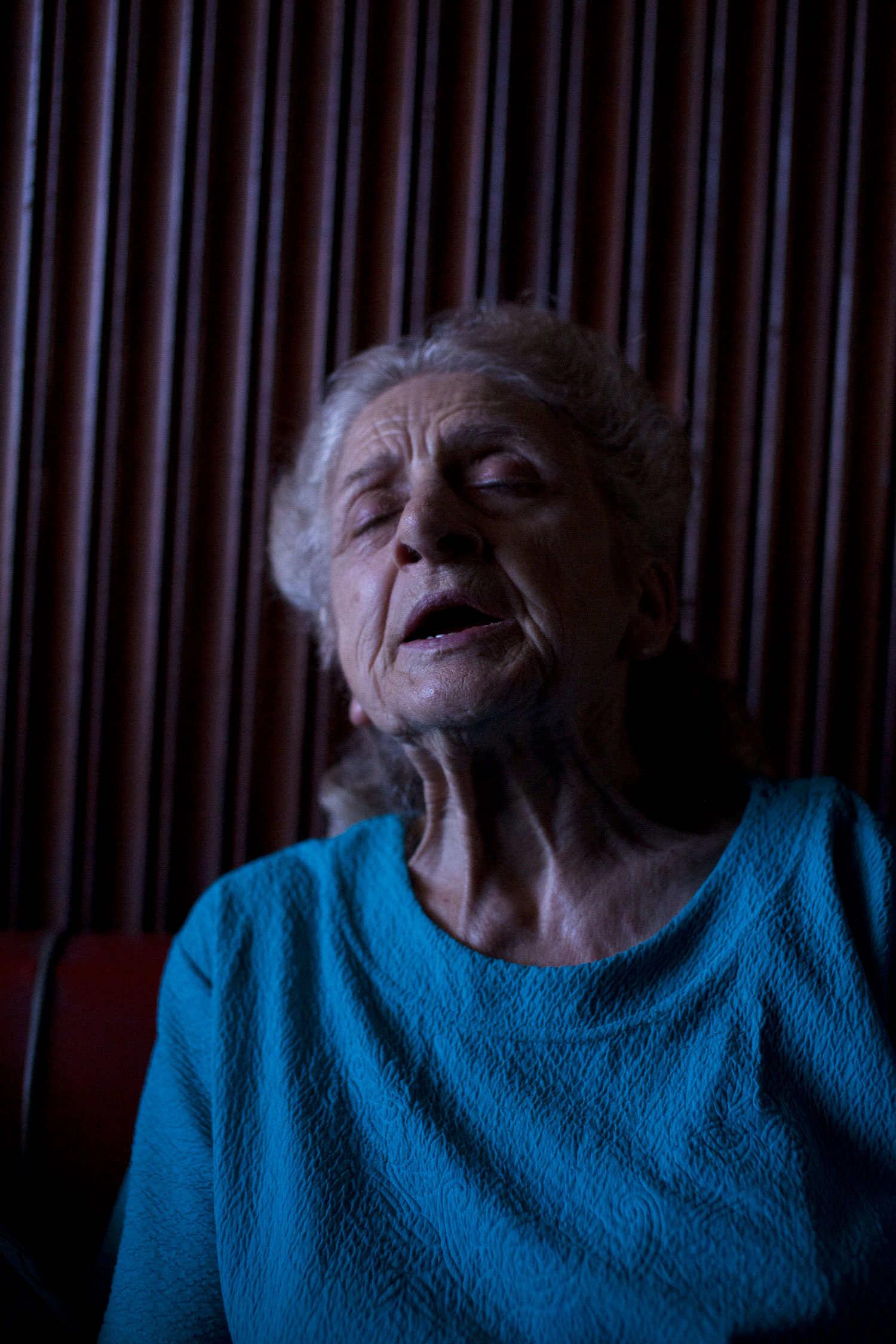
Julia Bondesson
Born 1983
“Feet”, 2018
Julia Bondesson’s primary focus is wood sculptures and performance art. She graduated from the Royal Institute of Art in Stockholm and has also studied hand puppetry in Taiwan and art in Japan and Thailand. A regular feature in her works is bodies and body parts charged with beauty and gloom. Like several of Bondesson’s other sculptures, “Feet” is at once both carefully and roughly hewn and carved. Gently, her works take possession of the gallery space, like seemingly passive entities awaiting activation and interaction. Bondesson is inspired by Chinese philosophy and tactile learning, where active interplay between the senses and the physical body is the focus of human development.
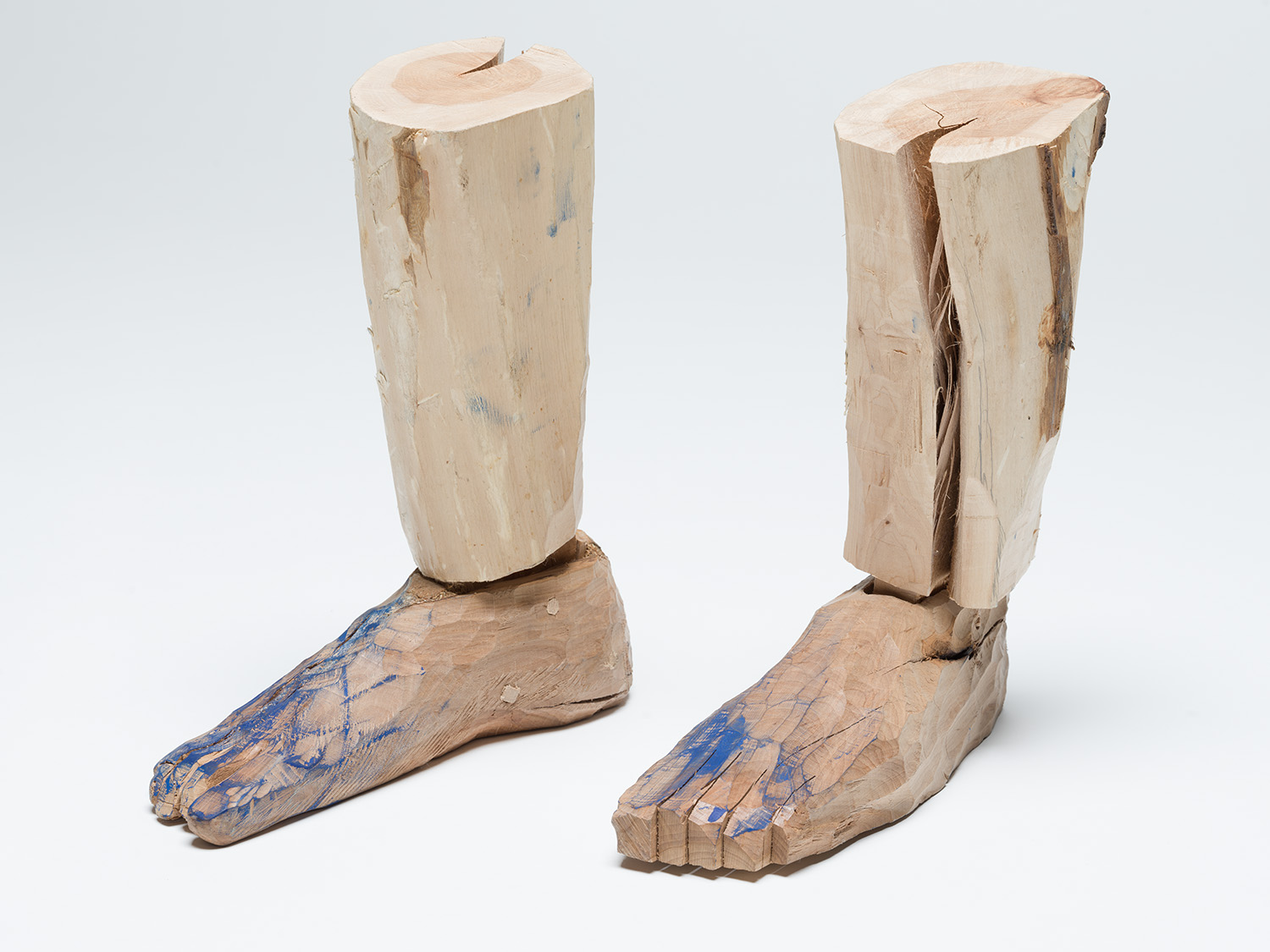
Jörgen Hammarberg
Born 1941
“SMOKES”, 1966
“SMOKES” is part of a series of paintings from the 1960s, created in a choreography with a dancing flame that sweeps across the canvas. Close, but not too close, since the object never was to perforate the fabric or create charred holes. Instead, the flame has tenderly caressed the air and touched the surface, leaving traces from the heat. A meditative concentration exercise, something every painter does now and then, but usually with a paint brush. A slightly distracted movement, and suddenly it’s too late. Like life itself: One mistake can change everything.
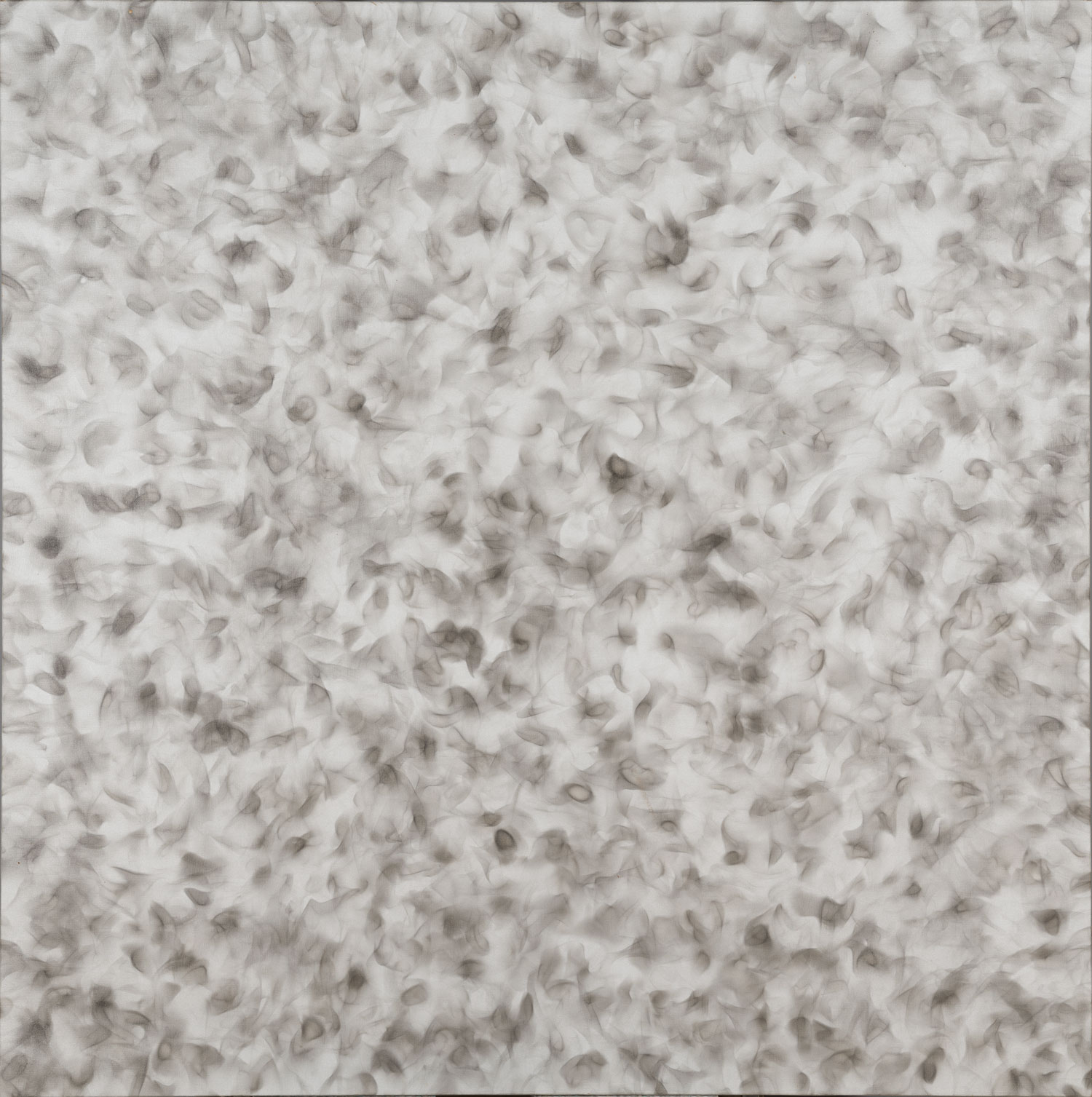
Kerstin Bergh
Born 1935
“O.P.”, 2019–2020
We are standing before an empty operating table, brightly lit by an old-fashioned green lamp fixture. Kerstin Bergh’s paintings emerge slowly and are never really completed. Throughout her artistic career, she has processed images that she is moved by and lives with. The image of pain is timeless, it is carved into us all. O.P. was written on the door of operating theatres in her childhood. The clinical subject matter does not contradict the personal and vulnerable. The darkness and colour sensations in this painting also relate to a specific memory of a moment under morphine sedation. Sandpaper in place of a pillow. The table has spindly legs, as though they were part of the human fragility they are supposed to support.
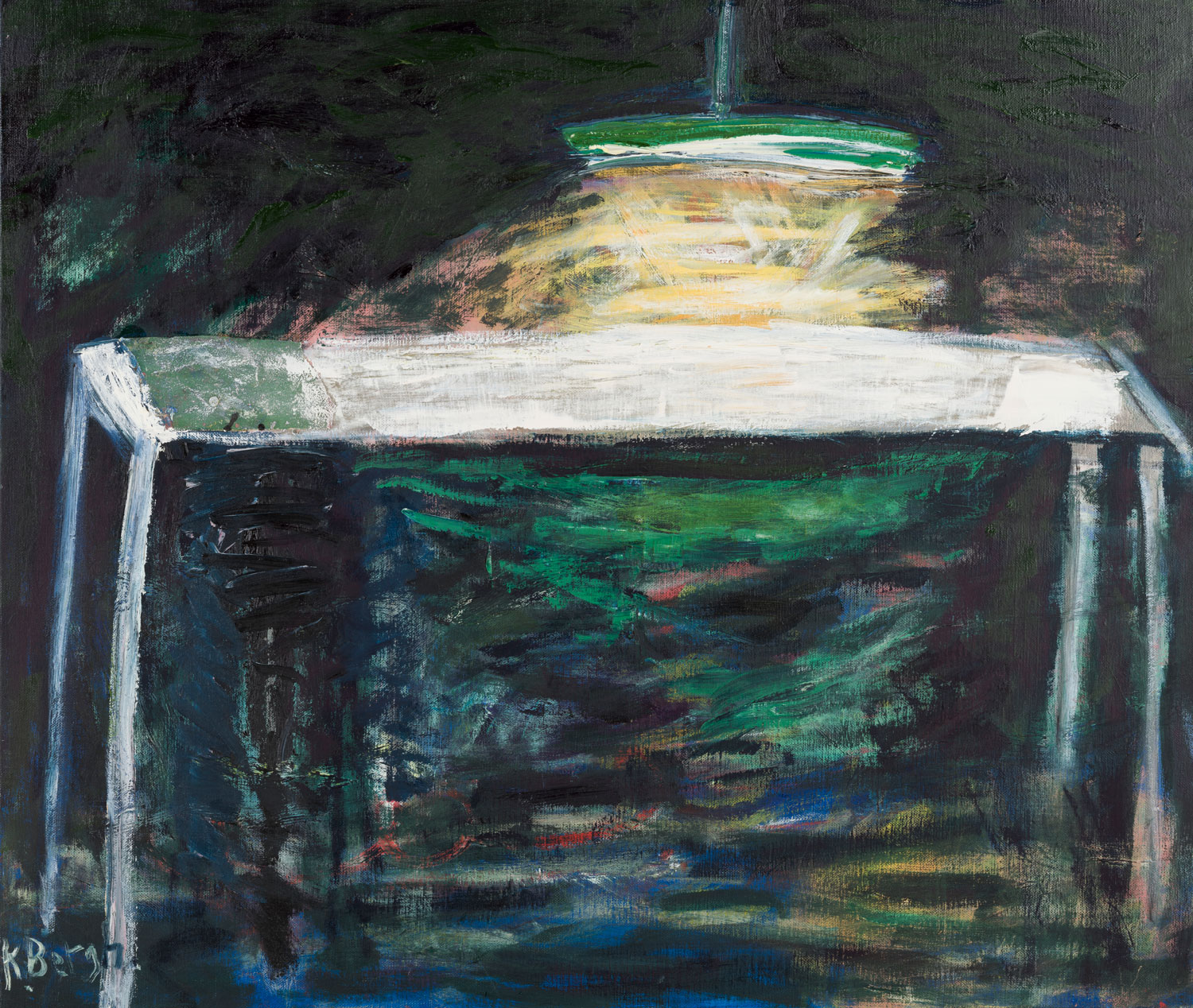
Kristina Eriksson
Born 1948
“Lena”, 2020
We are all going to die one day, no point pretending it isn’t so. Kristina Eriksson’s motifs are pared down to the bare essence. That which is about to vanish. Life. Traces of what has been removed in the process are visible in the many layers of paint. The colours are restrained to mainly nuances of white and grey.
In “Lena”, a woman wearing a coat moves towards a hazy destination with her back to the viewer. She is carrying a box of wine. Her shoulders are pulled up due to her burden, her age, the cold or loneliness. Or perhaps all of the above.
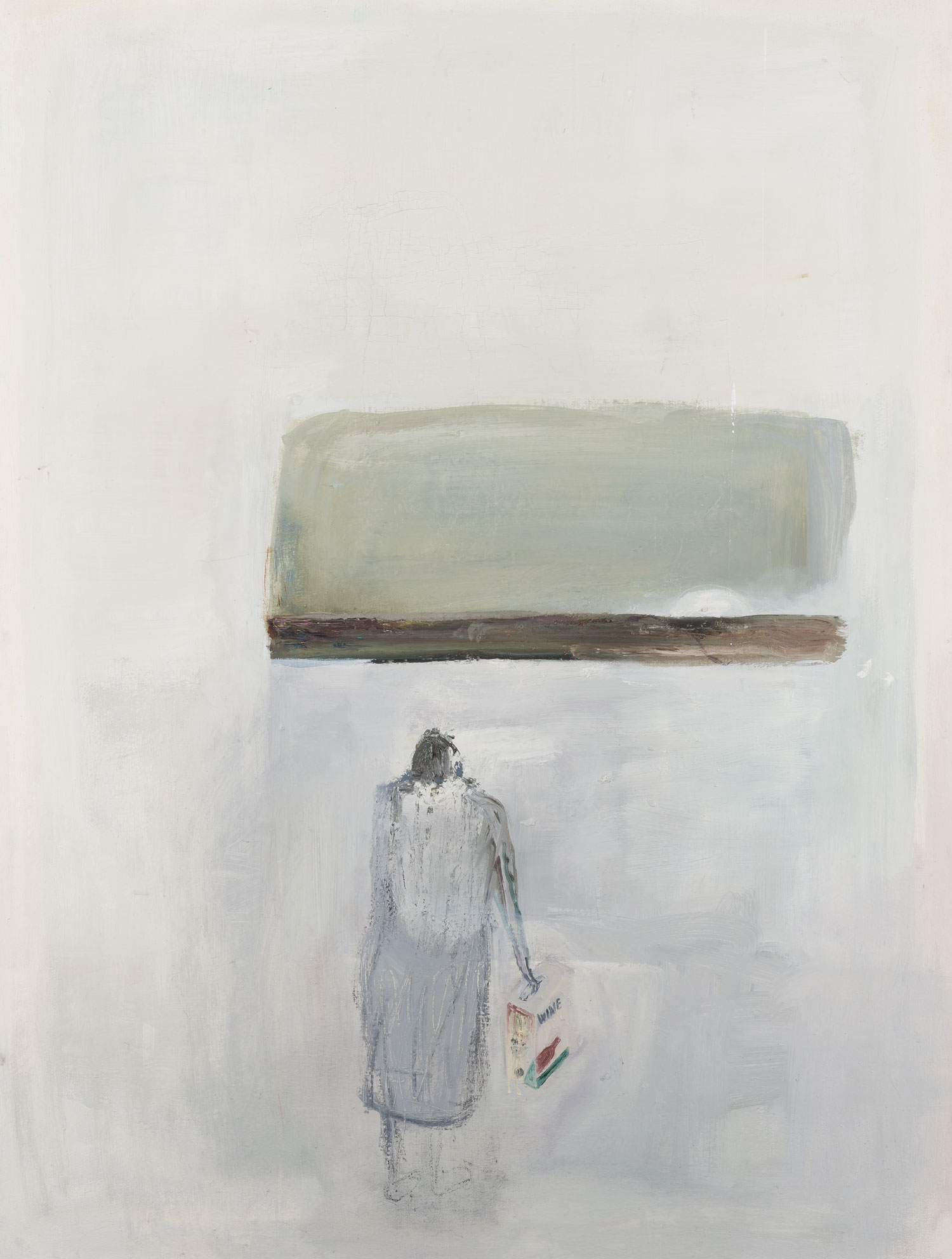
Lena Cronqvist
Born 1938
“Locked Up”, 1971
In a claustrophobic room, a woman stares vacantly into space. The bathroom sink and the door with a window for inspection and control show that she is in an institution. Locked up. The meatballs on the plate in front of her are arranged like numerals on a clock, the cutlery like hands. Time seems to stand still. In the early 1970s, Lena Cronqvist made several paintings of hospital settings, based on her own periods as a patient in a psychiatric ward. Throughout her artistic career, her themes have been both personal and universal: motherhood, childhood, loneliness, death and love.
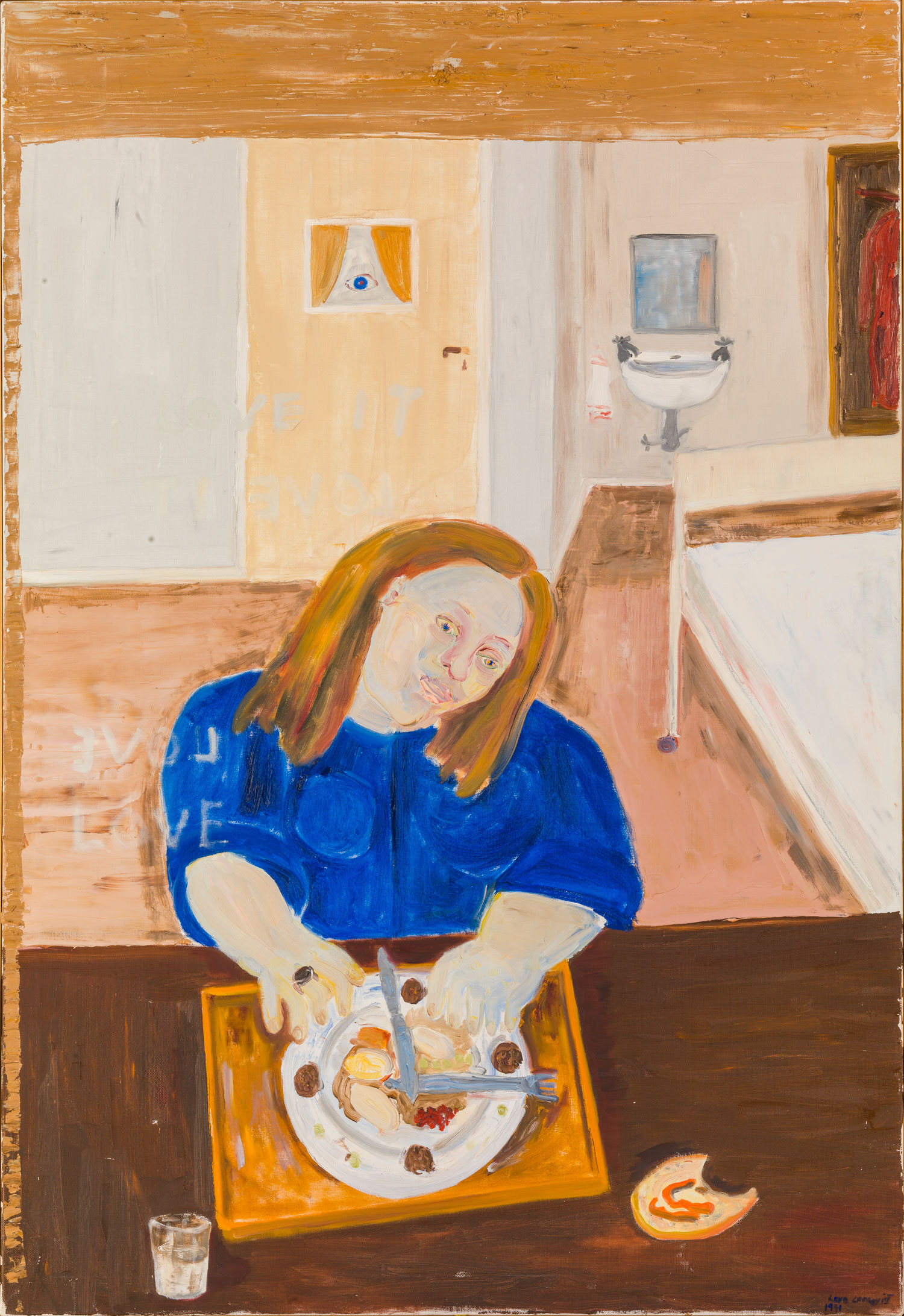
Margareta Hallek
Born 1932
“Variable figure”, 1985
Margareta Hallek belongs to a generation of young textile students at the Konstfack College of Arts, Crafts and Design in the early 1960s, who sought to expand the boundaries of crafts and to work freely with textiles as an artistic medium. Shaping fabrics with needle and thread was as natural and urgent to them as painting with brushes on canvas. Their art was rooted in the domestic sphere, using whatever was at hand and intertwining their practice with everyday life. “Variable Figure” is one of the works where Hallek explores the audience’s participation in designing the works. When it was first shown, viewers could alter the figure using pieces of elastic. A body in perpetual creation and change.
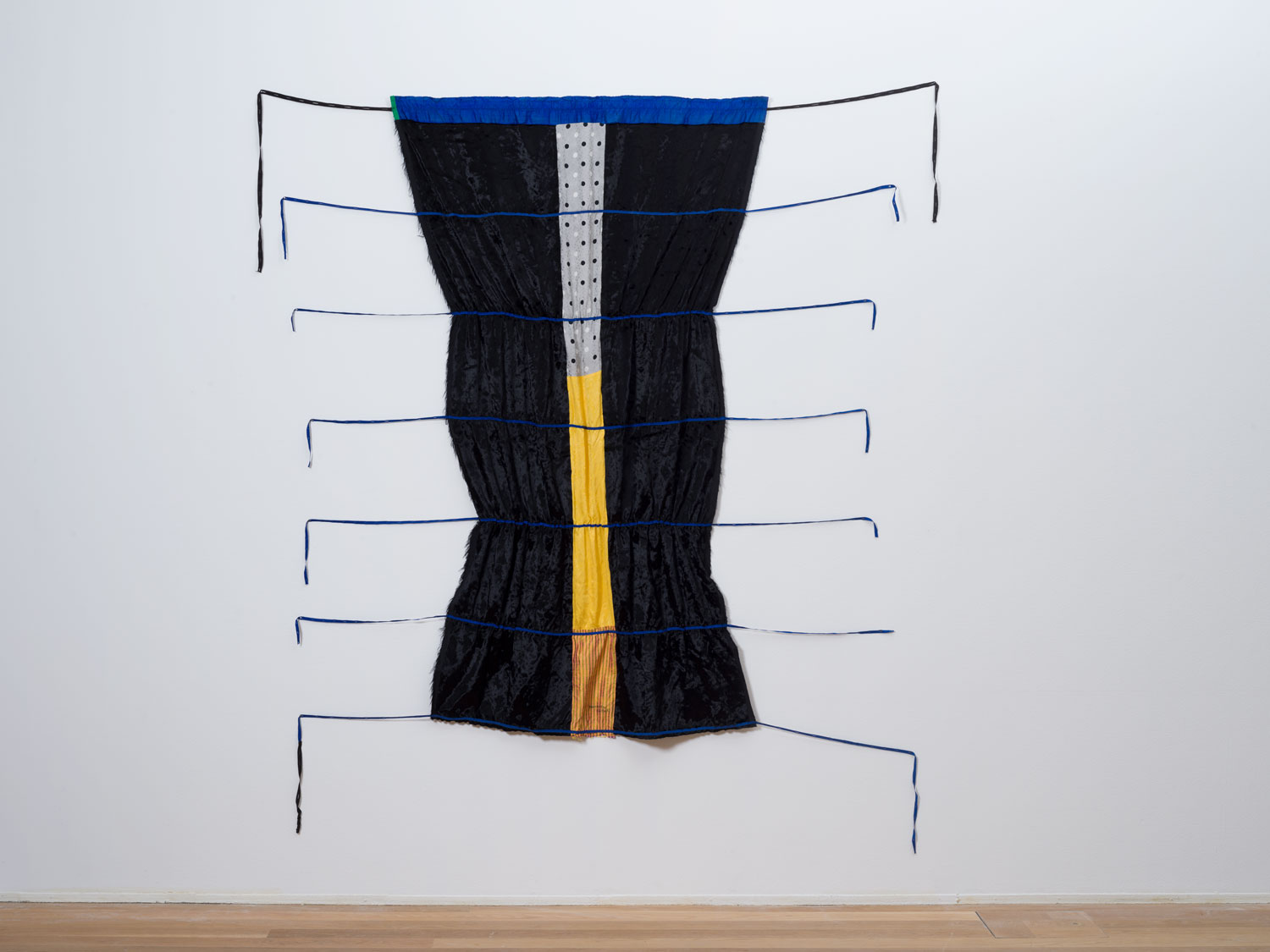
Mats Wikström
Born 1954
“The Agony of Growing”, 2017 and “I am an Artist in Norrbotten”, 2009
In the sculpture “The Agony of Growing”, Mats Wikström combines parts of a birch tree that were gathered and de-barked by the late wood carver Erik Norberg from Storuman. The burl in the middle resembles a brain, a branch a severed hand. To grow and change through crises and insights is painful, but there is also another side to this agony, the capacity to move on. The video “I am an Artist in Norrbotten” shows Wikström sitting in his kitchen with a cup of coffee. In the soundtrack, we hear him sing a melancholy song that progresses into fumbling hope. It is about the self-inflicted effort of working as an artist outside the major cities and still relating to the art world. Feelings of exclusion and shortcomings are evoked.
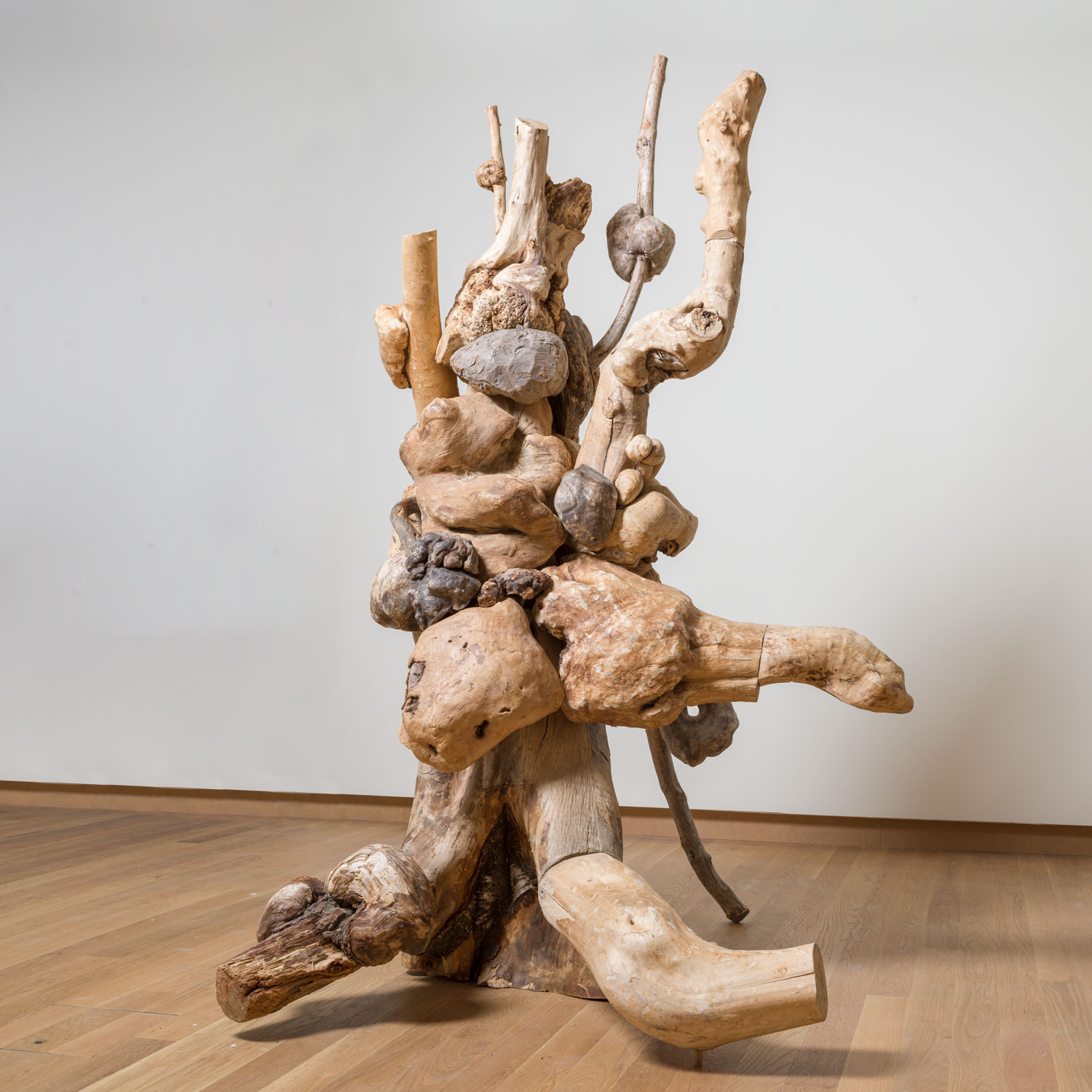
Matts Leiderstam
Born 1956
“Reconstruktion”, 1989–2016
In “Reconstruktion”, Leiderstam revisits two paintings he made in 1989. The motifs are from American gay porno movies made at a time when many people were dying from AIDS. When the two works were put up for auction by Bukowskis in 2016, the artist bought them. They were then restored and their context was recreated in a text on the artist’s private story, the provenance of the paintings, and their original subject matter. In 2016, the artist searched the internet and found the love scene from Leo and Lance that the red painting is based on. He also found information about the lives of the two actors: One died from AIDS and the other in a motorcycle accident while delivering food to AIDS victims. The work is a revised version, a reminder that bodies are human lives.
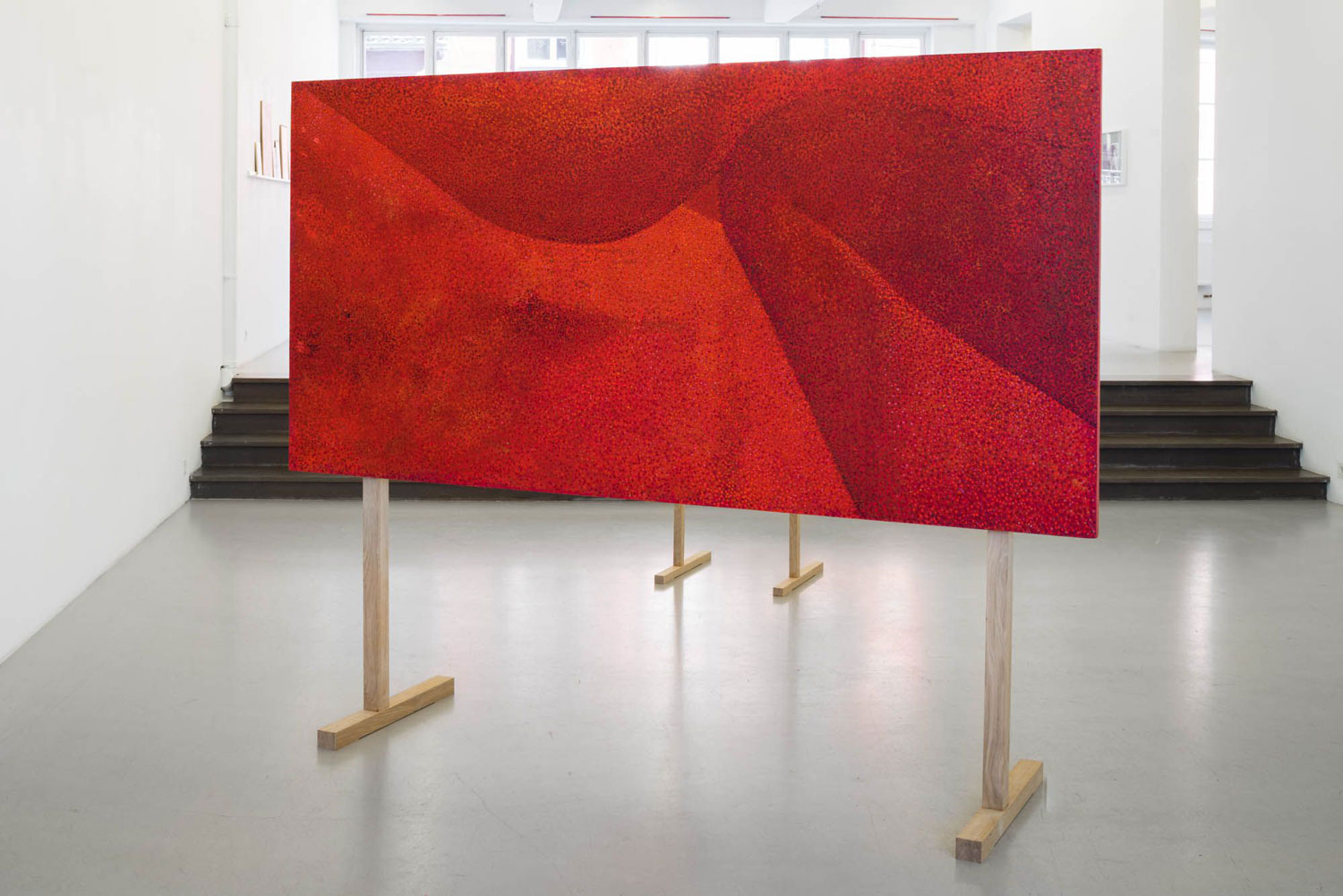
Meira Ahmemulić
Born 1974
“Foreign Land”, 2014
The video camera follows a woman from afar, wandering through a grey urban landscape. This distance creates a detachment between the observer, the woman and the large housing estate. Over the images, Meira Ahmemulić’s voice gives a factual account of relatives who have travelled across borders with their dreams and hopes of finding happiness in a foreign country. Ahmemulić talks of her mother. For a year, they worked as artists side by side. They mapped their conditions: the mother mapped her worn-out body, the daughter mapped the society around them. Is there room for exhausted bodies and yearning souls in a society that lacks mobility and empathy?
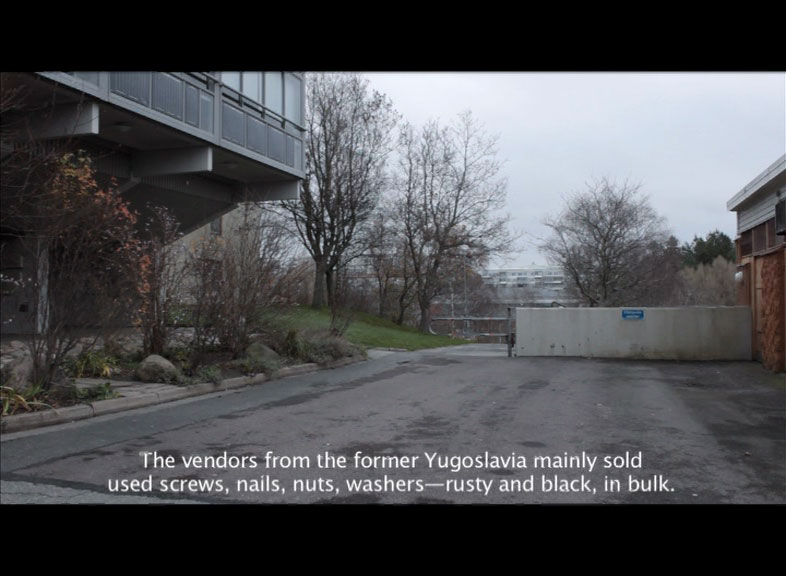
Mohammed Sami
Born 1984
“Joseph’s Coat”, 2020
This painting almost looks like an abstract, monochrome composition. But what we see in Joseph’s Coat is the blue reverse side of a garment. In his work, Mohammed Sami draws attention to the objects instead of the dramatic events they are part of. Often, his paintings hint at violence. The coat fabric seems to have been exposed to something – is it a silent witness? The title alludes to the story of the coat of Joseph from the Quran and the Old Testament. In the painting, and in the religious stories, the coat symbolises deceit, loss and trauma. With this work, Sami invites slow observation, where each one of us can use the coat as we wish.
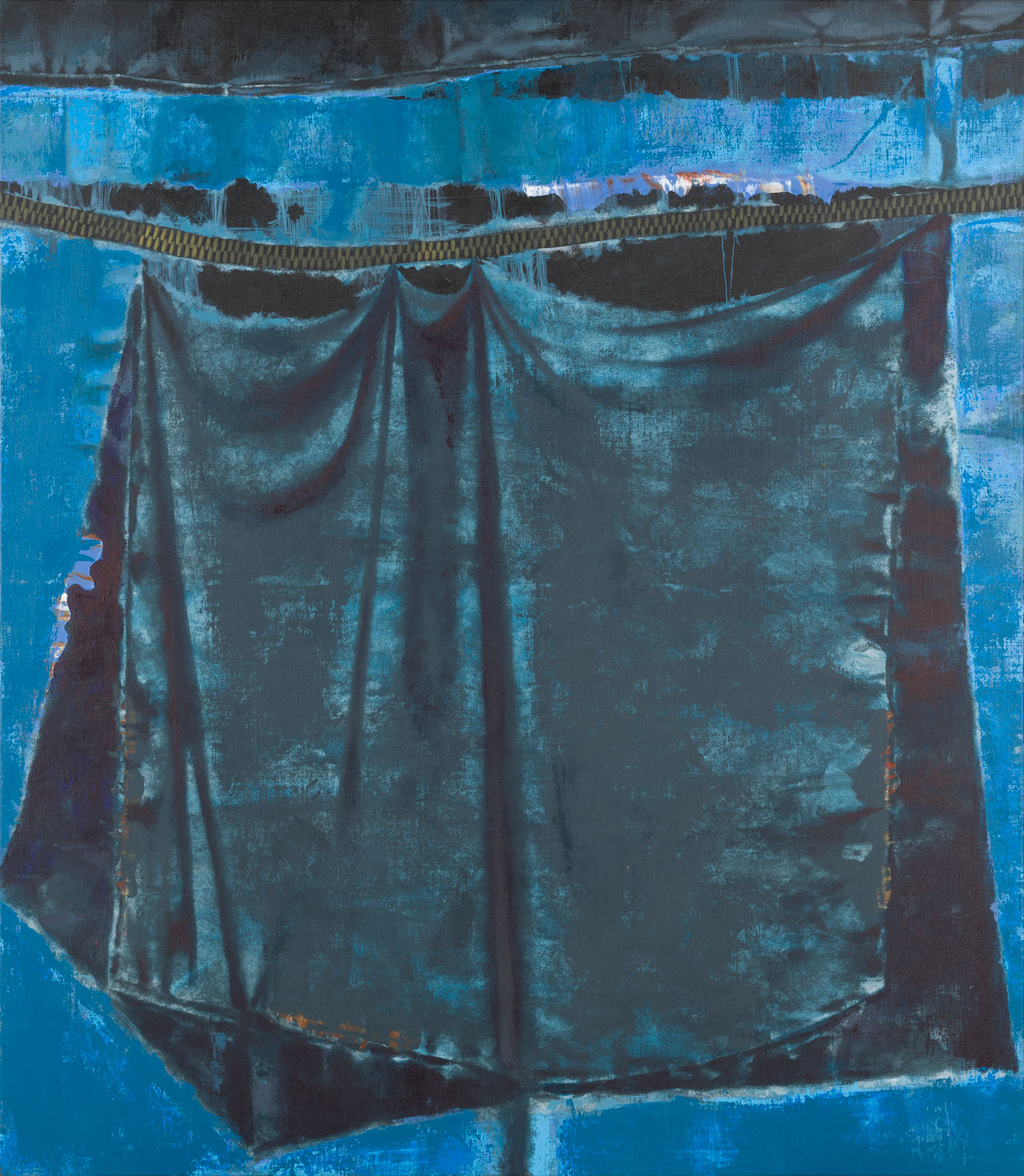
Nina Bondeson
Born 1953
“Signora Canedotto as Hanna Brooman”, 2014
Nina Bondeson’s imagery is frequented by a handful of fictional characters in different situations. Signora Canedotto made her entrance in the early 1990s, just when computers and Photoshop launched new ways of editing reality. Here, we see her as the composer and teacher Hanna Brooman (1809¬–1887). The Signora claims that we are living in the Lord’s 26th attempt at creation, and that the creation looks like it will be completely destroyed unless something is done. Therefore, it is the duty of every person to make the world a better place. The Signora has taken on herself to sort all the world’s things and phenomena, so that every object and event finds its rightful place. She worries constantly, but does not give up her ambition to improve the world.
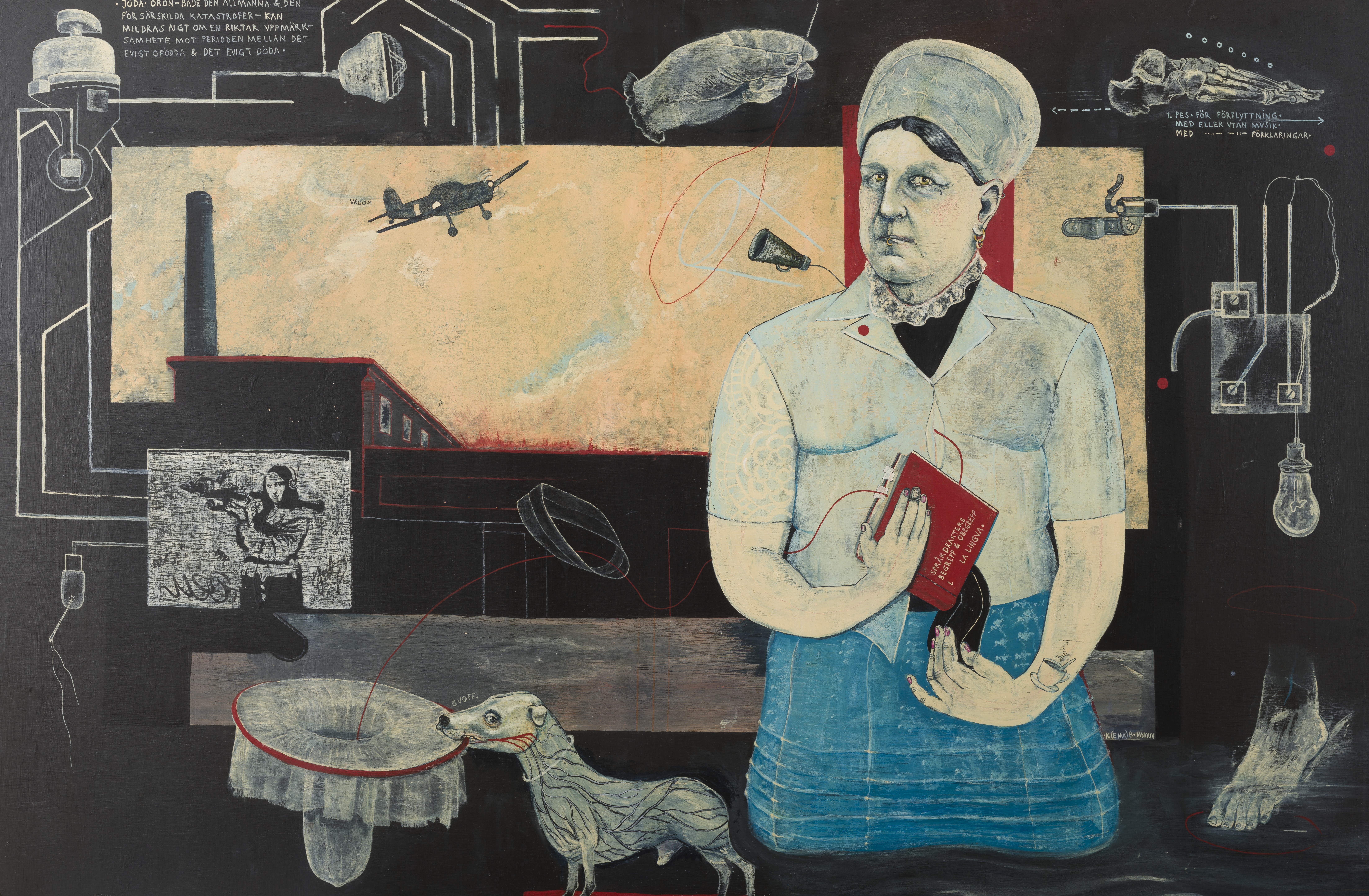
Olof Marsja
Born 1986
“eNAN”, 2020
Lanky, furry legs wrapped in plastic, arms like axe handles, a row of heads along the curve of the spine. “eNAN” was made in the wake of the Girjas case, when violent reactions led to cyberhate and illegal slaughter of reindeer, found in bin liners along the roads in the Gällivare district. Innocent and defenceless animals were used as pawns in a conflict between people. Olof Marsja’s sculptures combine organic matter used by humans since time immemorial, and chemically processed materials unhampered by memories. His figures remind us that these materials are not separate but coexist. They also seem to have agency and give the artist a method to transform and challenge the authority of those who write history. A way of processing grief and widening the perspective.
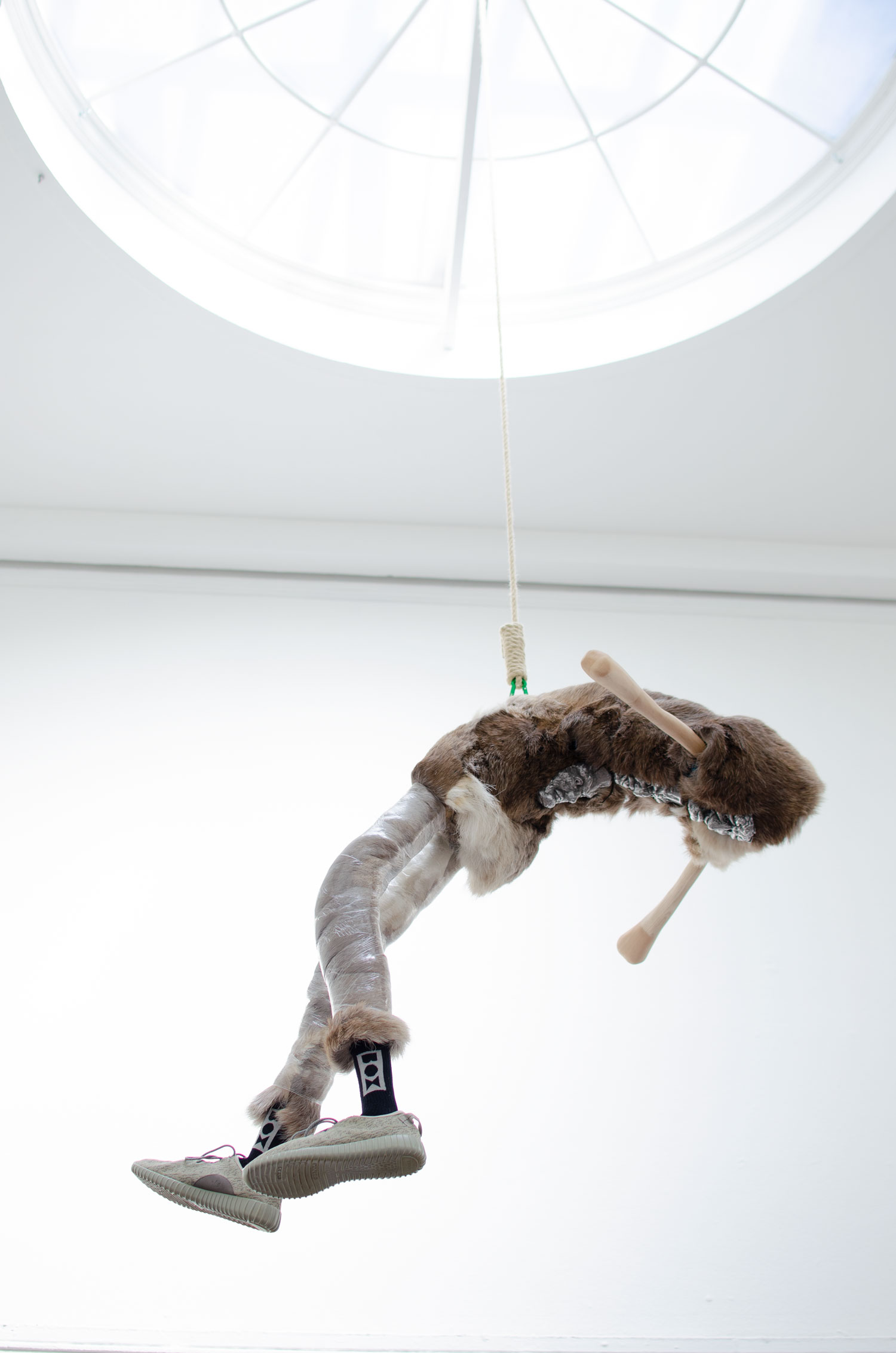
Oskar Hult
Born 1986
“Night”, 2019
In Oskar Hult’s works, the motifs appear like mirages out of the paint. Without any preliminary sketching, he applies thin layers directly, until the painting seems to hover between alternative potentials. Sometimes, the same pictorial element is repeated in the paintings, infecting and turning up on several canvases in the process. In the monumental “Night”, a few lines draw a geometric form, at the centre of which four eyes gaze obliquely upwards. A shimmering intensely yellow dot shines in the blurred sea of colour. The subtle veils and more compact colour fields can evoke a sense of different strata or worlds.
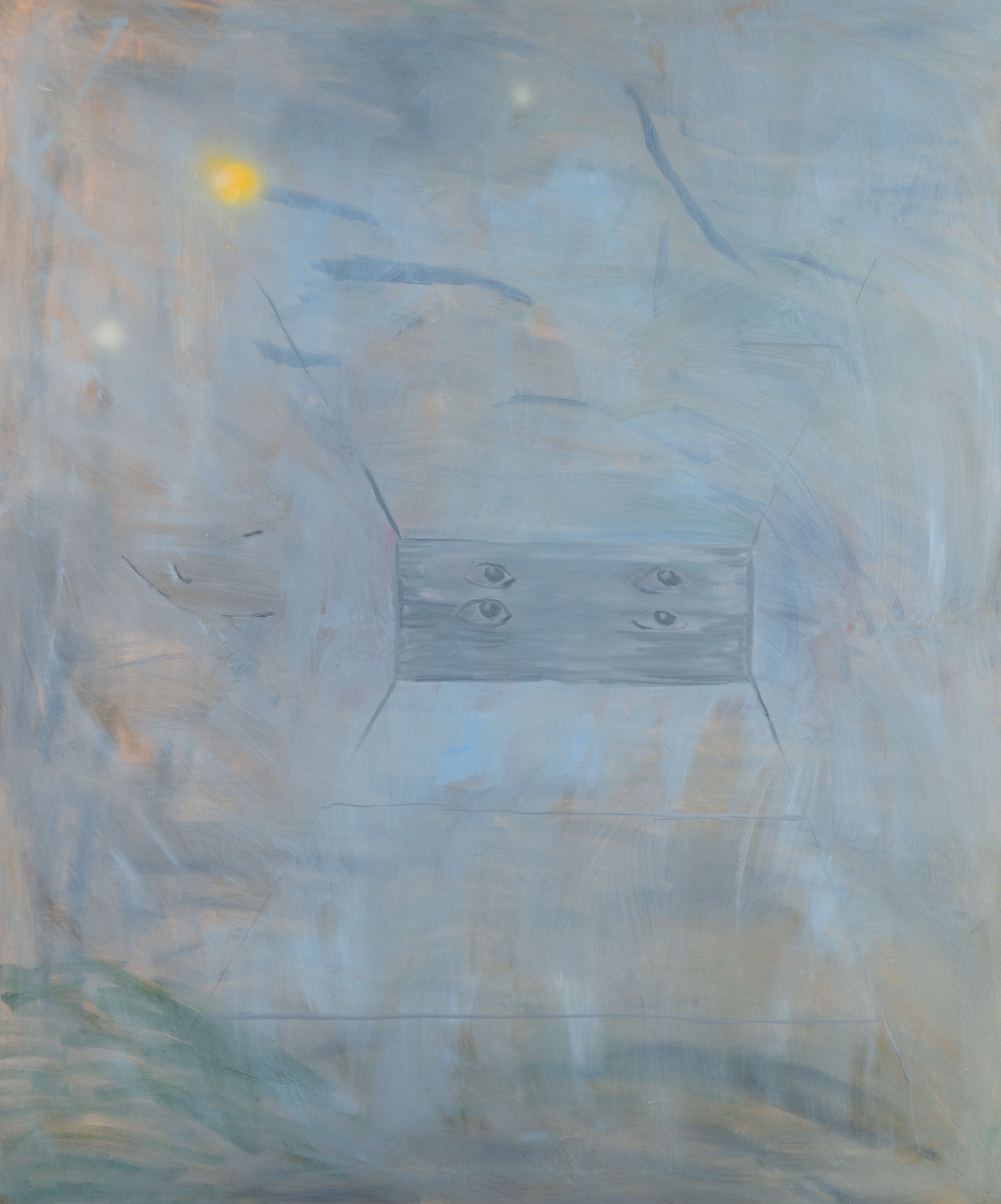
Patricio Salinas A
Born 1949
“Atacama, the Geometry of Imprisonment”, 2020
In this work, the photographer and writer Patricio Salinas A returns to the prison Chacabuco in the Atacama Desert in Chile. After the military coup in 1973, hundreds of prisoners were taken to this abandoned mining town, which the junta had ordered to be surrounded by barbed wire fencing and minefields. Patricio Salinas was one of these political prisoners; he was number 32. He came to Sweden in 1976 and has visited his native country several times in recent years. In these black and white photos, Salinas has documented the place and attempts to reconstruct and share his experiences. On his many journeys, he has repeatedly asked himself how much of him was left behind in Chacabuco. Memories of the place linger within, like unrelenting shadows.
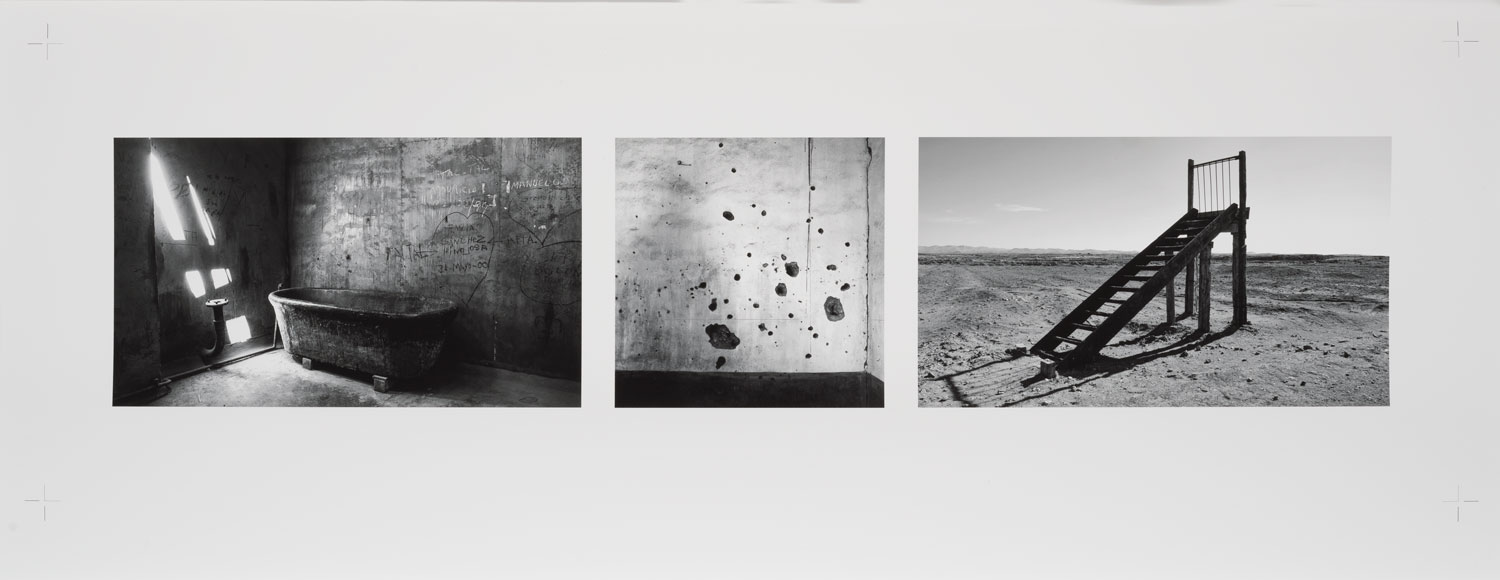
Patrick Nilsson
Born 1966
“Thicket”, 2020
The thicket fills the entire surface. In earlier works, Patrick Nilsson has portrayed various violent acts against a background of terse architecture or among tree trunks straight as columns. These works raise questions about complex subjects, such as the presumed masculine nature of aggression. Nilsson’s recent works, instead, are underpinned by a calm, myopic observation of the surrounding verdure. Trees, bushes and flowers are unkempt and spread organically across the sheets of paper, seemingly oblivious of any prominent narrative. Nature is sufficient unto itself.
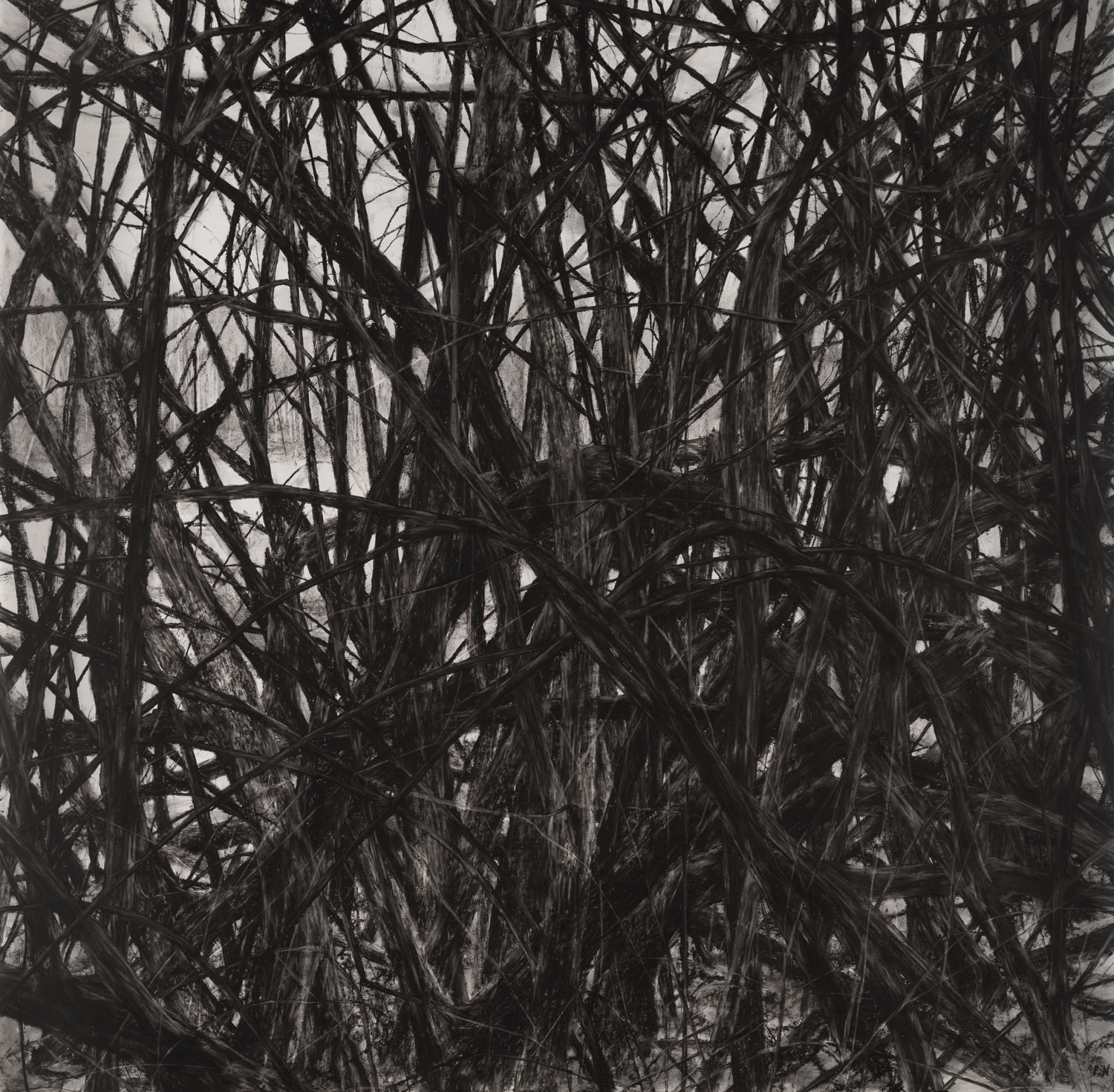
Peter Wallström
Born 1960
“Only in Your Mind”, 2018 och “The Last Revisit”, 2019
Something is about to happen. Here, Peter Wallström creates scenes populated with mysterious figures against a backdrop of dreamlike landscapes and buildings, shimmering celestial bodies. Like the characters in “Only in Your Mind” and “The Last Revisit”, we are drawn away or towards a place within ourselves. One of Wallström’s sources of inspiration is Caspar David Friedrich’s early 19th-century paintings, with averted figures against wondrous panoramas and skies – the small human being faced with the great mystery. In Wallström’s paintings, the unprimed canvas is often glimpsed, and the tender treatment of coloured materials, glitter glue and applied pieces of canvas, give a tactile quality to the surface. The works can be experienced in new ways every time we see them again.
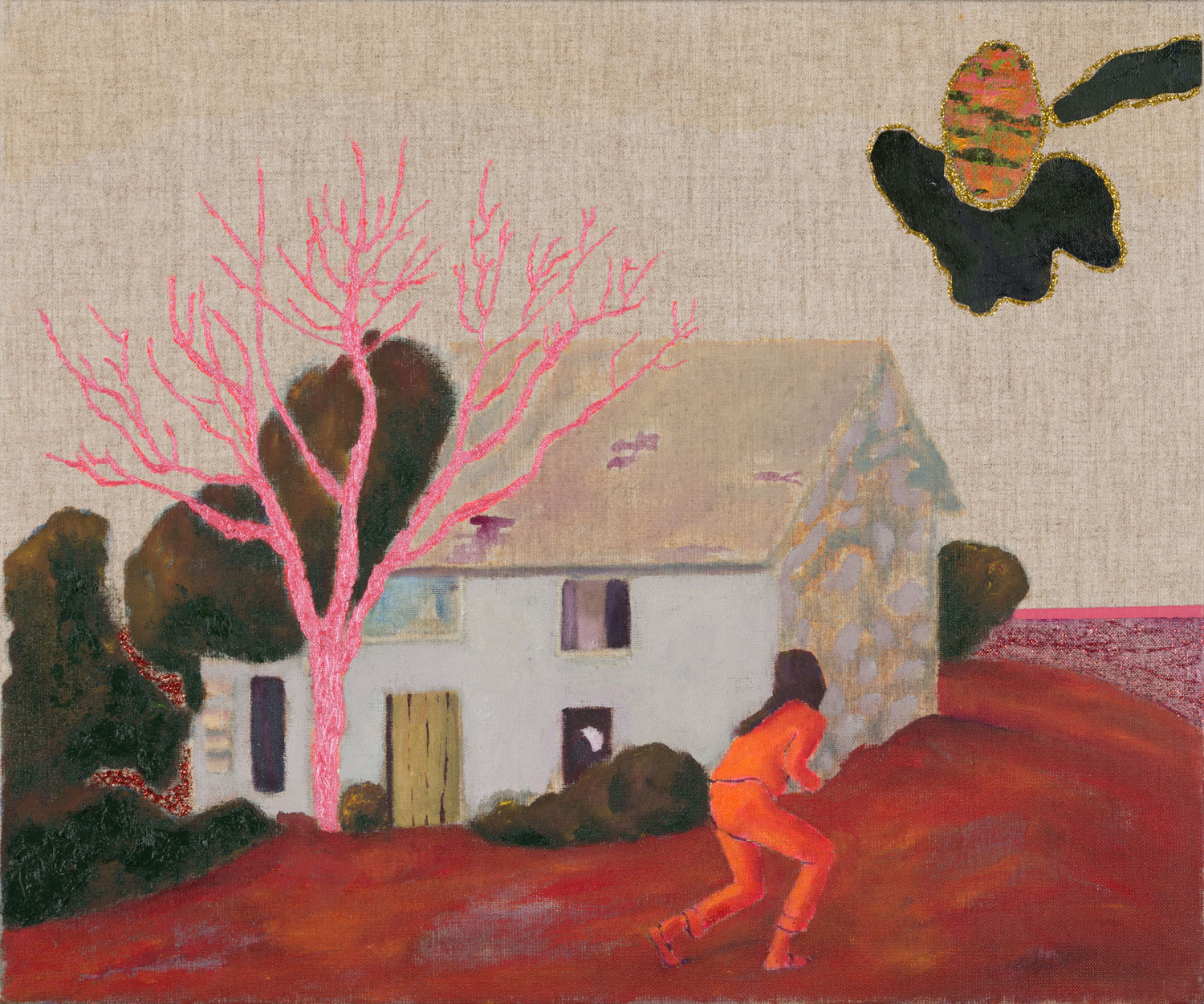
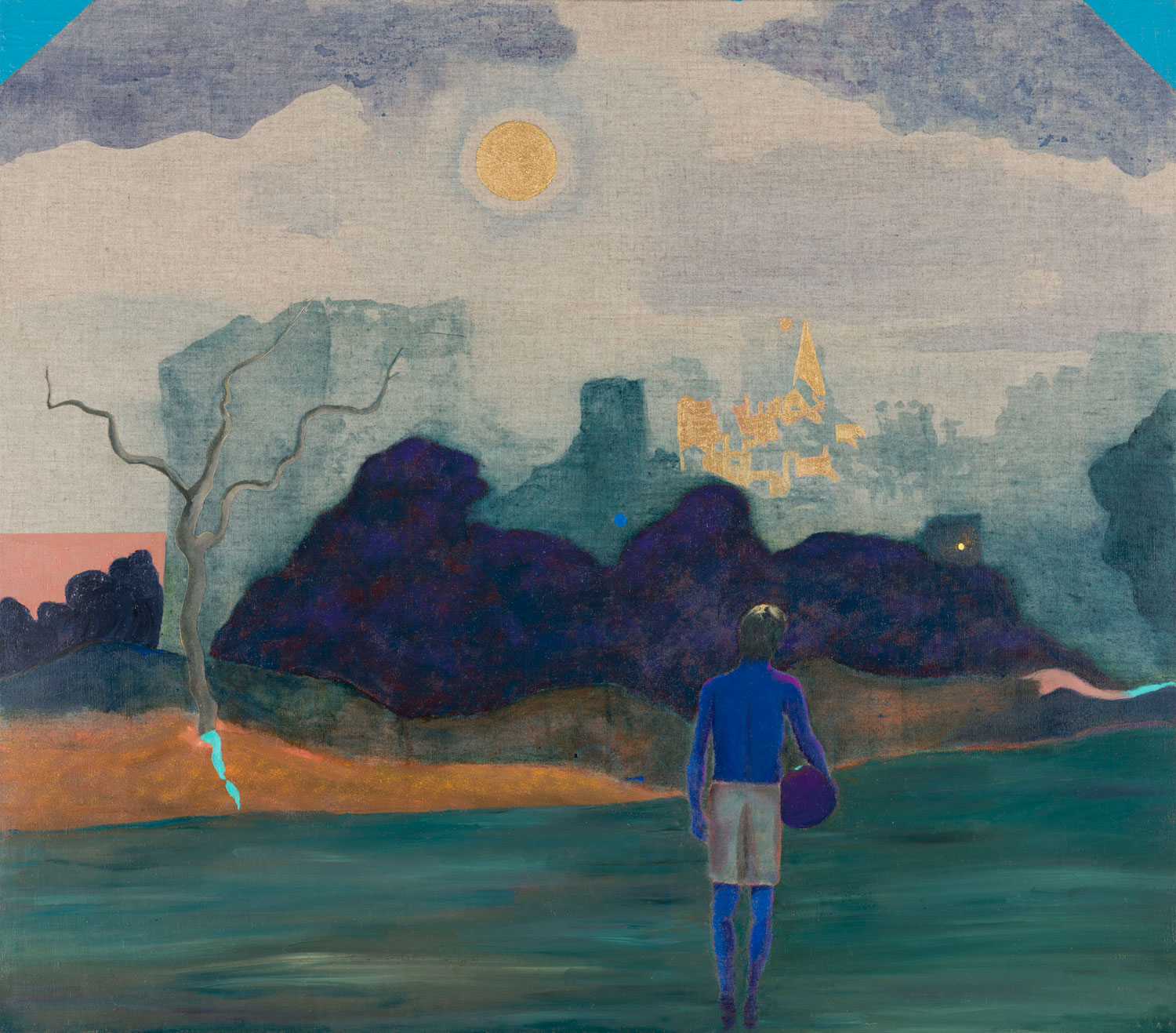
Petronella Petander
Born 1977
“The Haven”, 2020
One blip gets them inside the warm laundry room. This unique place was invented for the Swedish welfare state to make modern life easier and cleaner, and to create a sense of community. In the past, it was a meeting place for the local women, who were the ones who did the laundry; today, neighbours pass each other here in shifts. But some people use the laundry room as a temporary refuge, where they are included in an everyday context, if only for a booked time slot. A place that nurtures the dream of belonging. For those who wash sleeping bags instead of sheets, and who seek out the warmth of the drying room when it is cold outside, the laundry room manifests the gap between the dream of the welfare state and its dismantling.
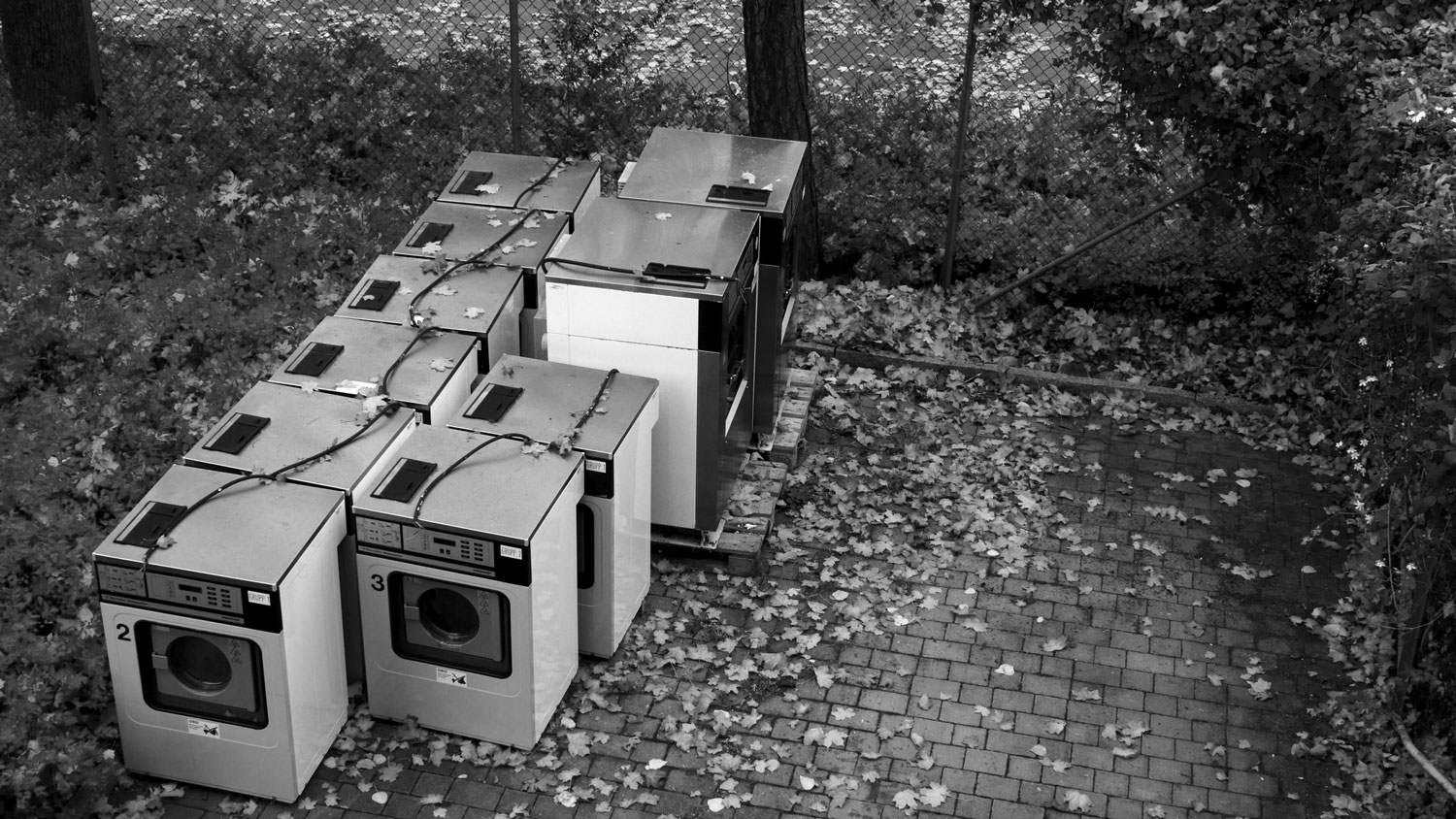
Sigrid Holmwood
Born 1978
“Bones”, 2021
Sigrid Holmwood’s work is based on extensive research on the production of natural pigments and the colonial aspects that are linked to these processes. The artist highlights how oppression of indigenous peoples and the peasant class has led to a loss of knowledge, not least about plants and their properties. There are also parallels to the witch hunts in the past, which were partly founded on the condemnation of certain knowledge, including the medicinal use of plants. Holmwood develops the knowledge about plant characteristics and their uses and applies it in her practice to create paintings and textile prints. The pattern in “Bones” is partly from an 18th-century print, used as a sign of caution on the doors of houses afflicted with disease.
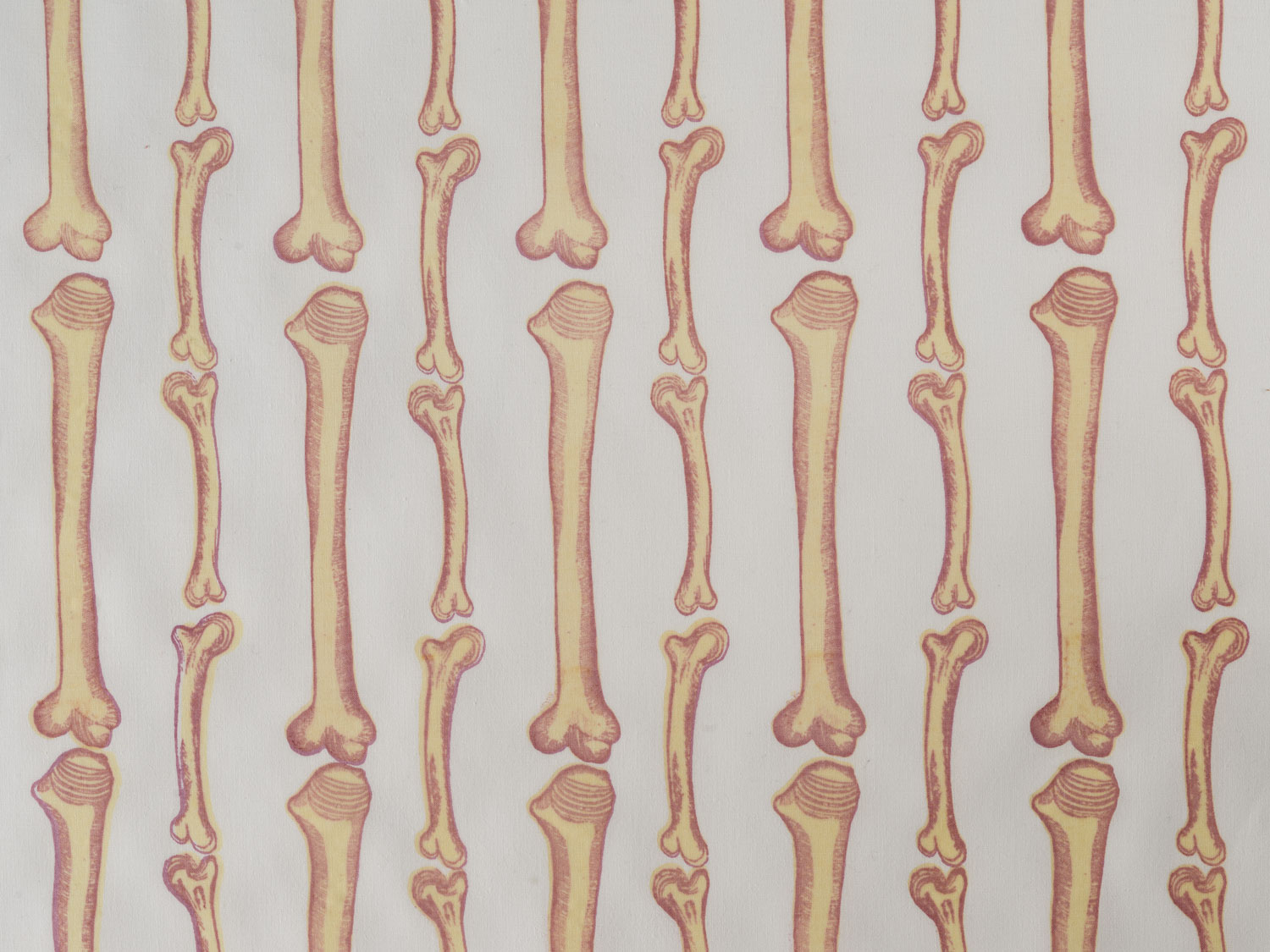
Snežana Vučetić Bohm
Born 1963
From the Series “Self-Portrait 1991-1994”, 1991–1992
In 1991, when Snežana Vučetić Bohm was studying at Nordens Fotoskola, she was asked to make a documentary photo reportage. Equipped with a stand, a self timer and a Rolleiflex camera – a classic model for photo journalists – she travelled to Yugoslavia, which was on the brink of civil war. Her choice to work in black and white is also in keeping with a long tradition of photo journalism. But in the midst of the political conflict around her, she turned the camera on herself. Both the tank on the bookshelf in her cousins’ home and the barbed-wire fence in the landscape near her grandmother’s house seem to prophesy the looming war. Vučetić Bohm meets our gaze as both observer and observed, as the human being she is, in a terrifying and incomprehensible situation.
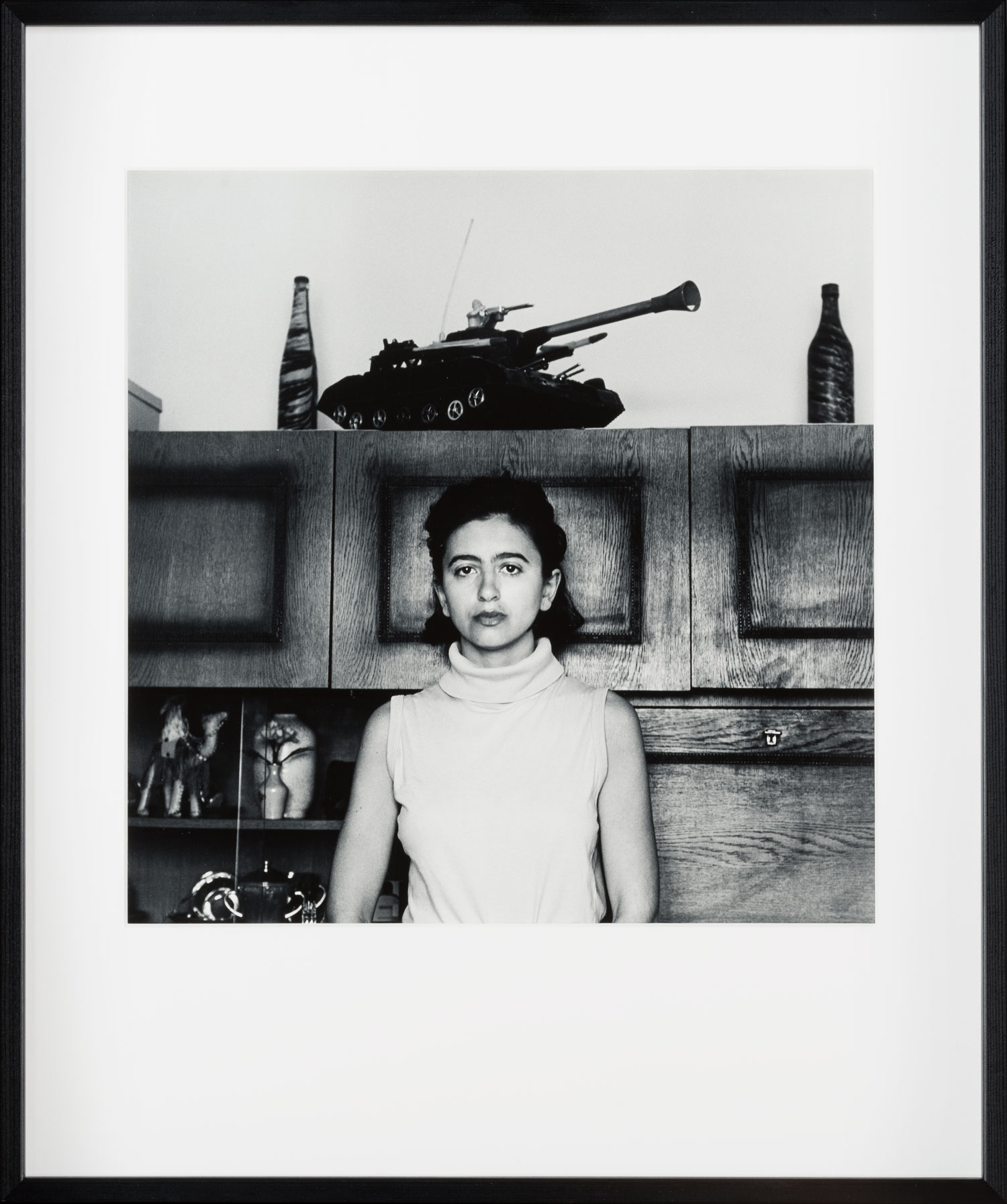
Stina Siljing
Born 1962
“I Count to 27”, 2021
Thoughts about how fragile life is, and what remains when life ends, infuse Stina Siljing’s artistic oeuvre. Her paintings focus on cell structures, the building blocks of all life in plants, animals and humans. She also began making objects out of organic materials that bear the traces of vanished existences. In “I Count to 27”, the artist has counted the year rings in a piece of elm wood. She has carved out the twenty-seventh ring and made an inlay of silver leaf. The work belongs to a series she made to process her loss and grief after her son’s suicide. The wood piece has the same dimensions as the scarf he always wore, and which he had hung up carefully at home.
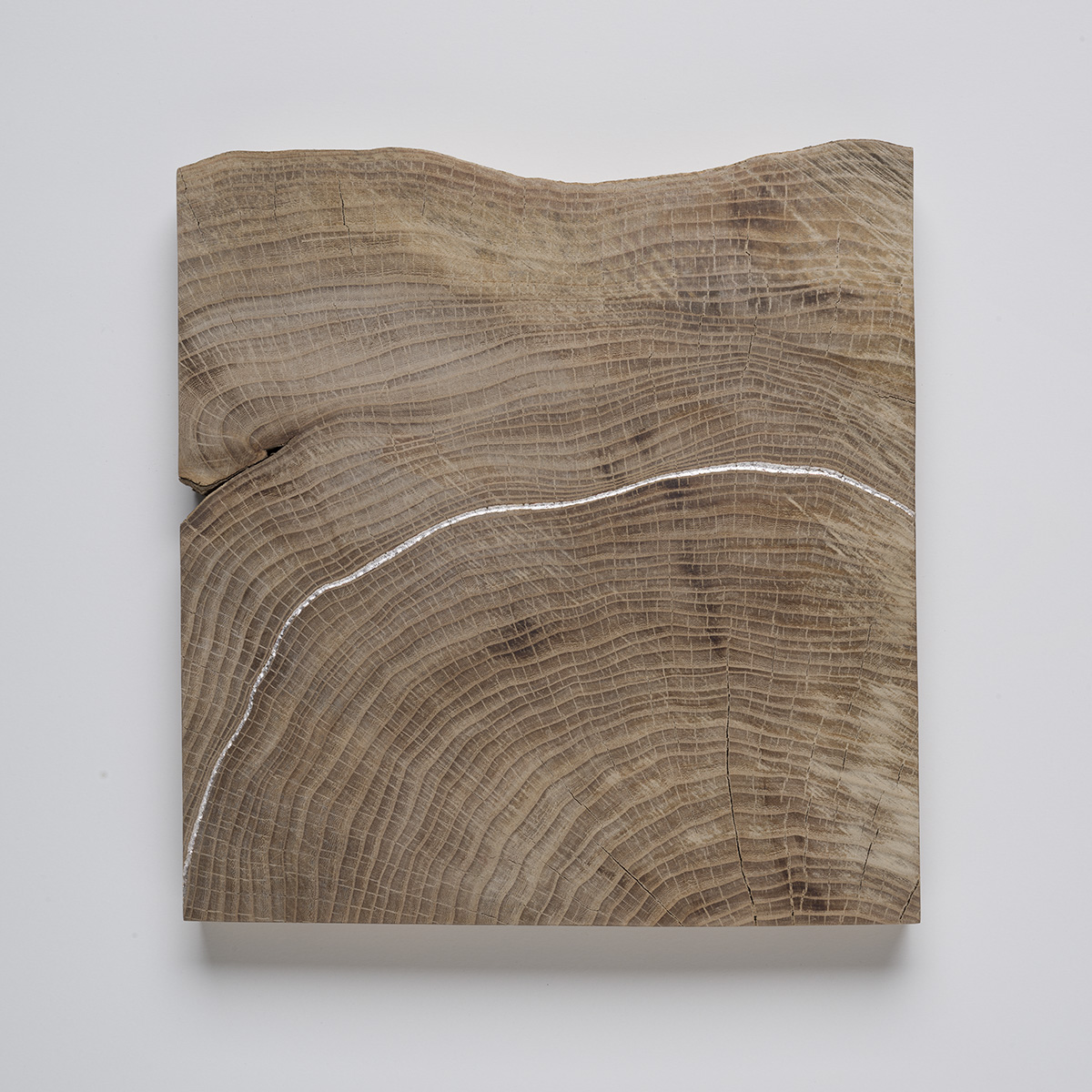
Susanna Jablonski
Born 1985
“Neon Circle”, 2017
Susanna Jablonski’s sculptures can resemble things we find in everyday life, or they may consist of fragile materials that are processed into abstract objects. The physical structures often balance on the line of what is possible to sustain. Here, a halo of violet light hovers above a bed of lavender in the same colour. This neon circle measures 163 cm in diameter, corresponding to the artist’s body length and wingspan. A closer look reveals that the circle is incomplete, and that the two elements of the sculpture are held together by light only. Lavender is a plant said to have healing properties.
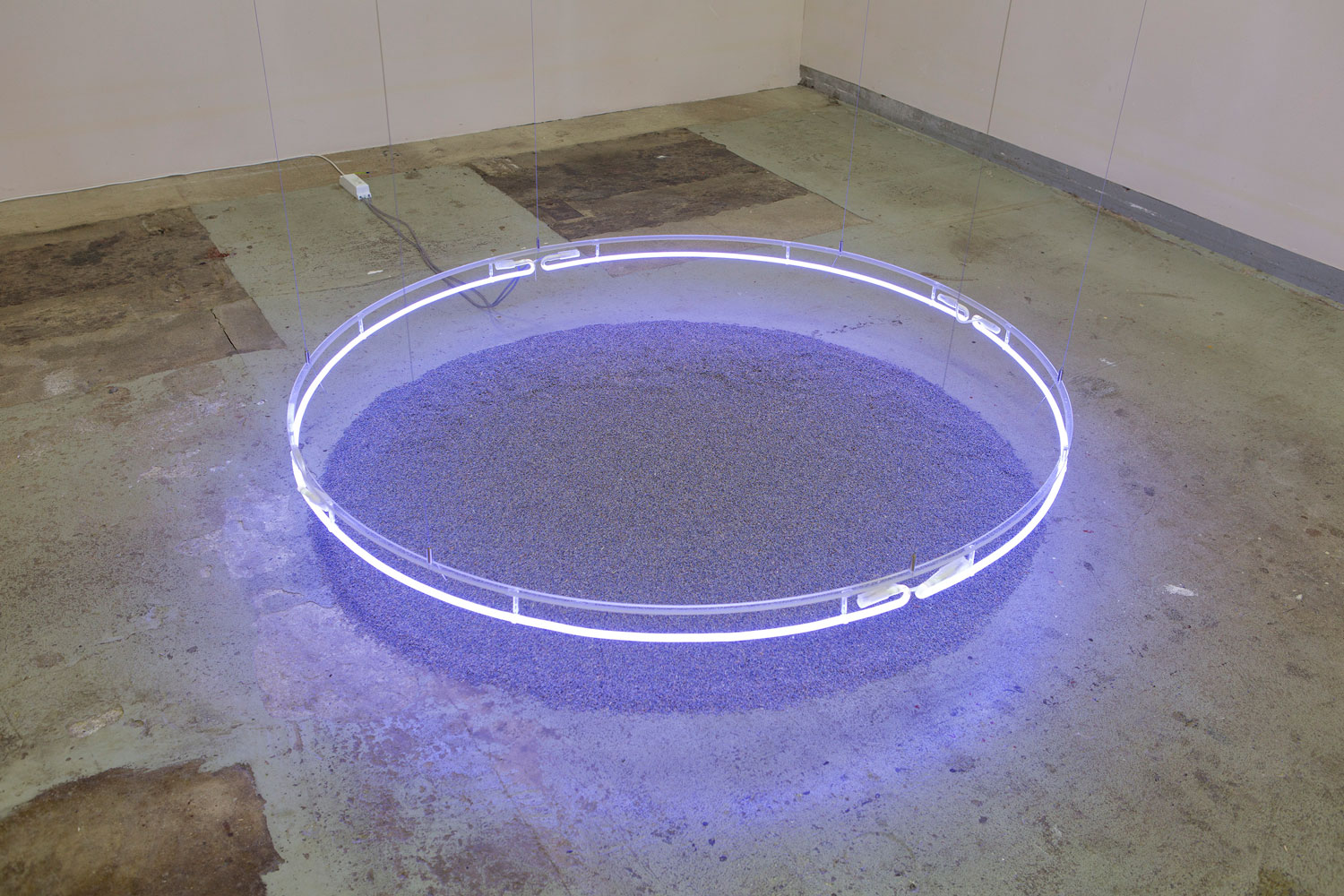
Thomas Wågström
Born 1955
From the series “Necks”, 2010–2013/2021
The series “Necks” is the second part of a trilogy by the photographer Thomas Wågström, where he works with different perspectives. In the first part, he studied cloud formations seen from the ground; in the third, events, situations and people on the ground are captured from his flat on the thirteenth floor. The neck is studied here, perhaps the most constant but also invisible and vulnerable part of our body. Wågström has photographed the necks of some fifty young and old people, family members, friends and strangers. They form a tender collection of images, revealing and awakening memories of the longing to kiss the soft neck of a child, to caress this secret part of our lover, and the surprise of realising that we recognise the rear view of a familiar person so well.
